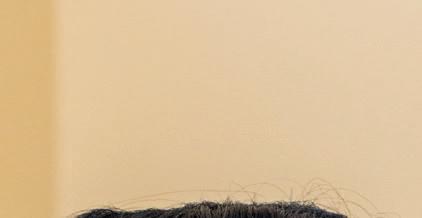SCHOOL’S BACK
7TH ANNUAL HIGH SCHOOL FORUM MUST-HAVE GEAR THAT MAKES THE GRADE


WHEN YOUR CHILD SHOULD SEE A VISION PRO
+ SPECIAL REPORT IS THERE A FUTURE FOR ON-DEMAND MEDICAL CARE?


Humanity that exceeds it.

















7TH ANNUAL HIGH SCHOOL FORUM MUST-HAVE GEAR THAT MAKES THE GRADE


WHEN YOUR CHILD SHOULD SEE A VISION PRO
+ SPECIAL REPORT IS THERE A FUTURE FOR ON-DEMAND MEDICAL CARE?


Humanity that exceeds it.






















We are proud to honor our Founding Partner Samuel L. Davis, for his recognition by the New Jersey Law Journal for achieving the largest reported New Jersey Personal Injury Settlement during the Court’s 2022-2023 term.






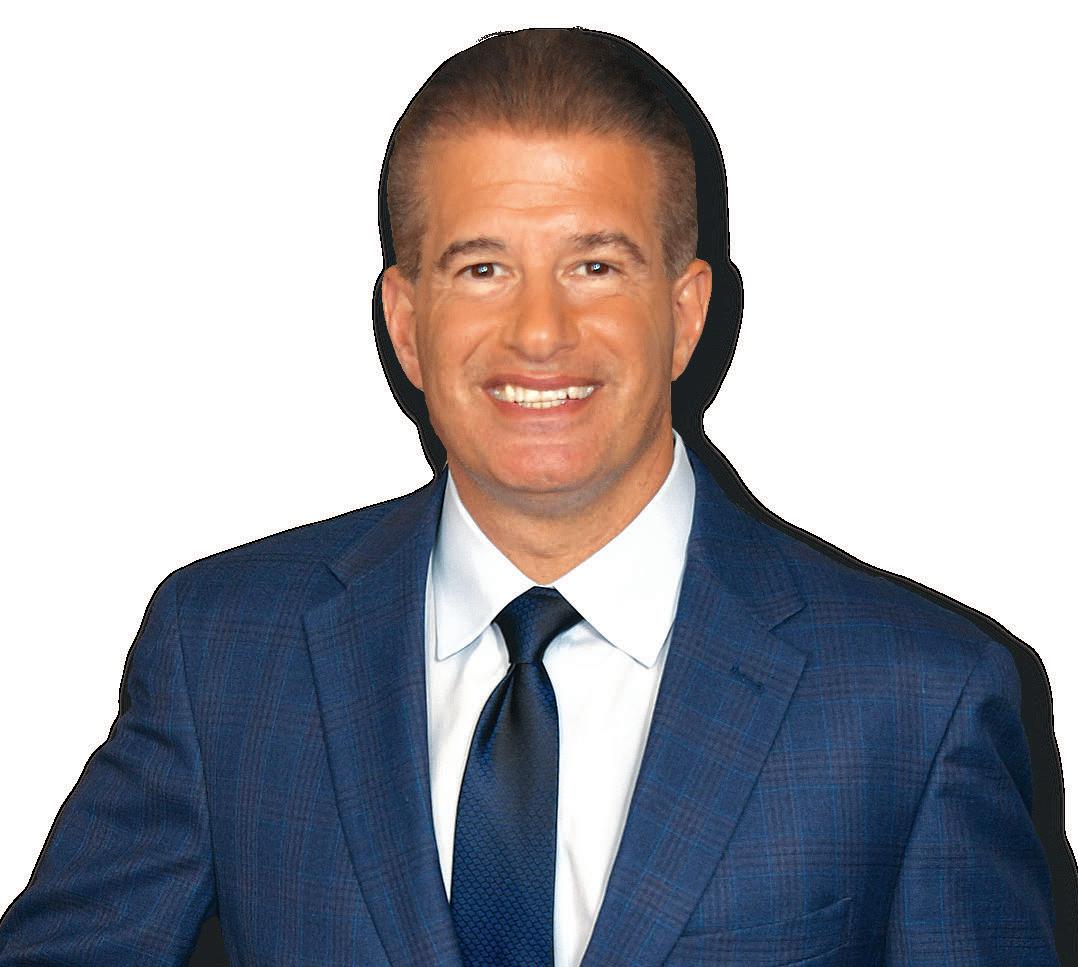

























Can Your Child See 24
If the blackboard is a blur, trouble lies ahead. But regular checks with an eye-care professional can help.
The Kids Are All Right 26
This year’s BERGEN conversation with 12 rising high school seniors shows them to be thoughtful and articulate—if also, like, a little worried.
38 16 20
First-Class Treatment 34
Concierge medicine offers an enhanced relationship with the doctor for those who can pay extra. But what about those who can’t?
When A Builder Dares To Dream 38
During the pandemic, a rare opportunity presented itself in Franklin Lakes. The end result? A home of enduring luxury.
A Sommelier’s Summer Picks 46
It’s a time to go easy with the meal you serve with just the right companion sip for each course.

48
Bergen Buzz 11
Our guide to new ideas, tips, trends and things we love in the county.

Home Front 16
Blue is a cool hue that can bring new life to any space.
Kids’ Corner 18
Get high marks with the coolest gear of the year.
Friends & Neighbors 20 When

Teaneck’s Angela Logan needed to make some money fast, a recipe came to the rescue.
Twelve rising seniors participate in BERGEN’s 7th annual High School Forum.
Photo by Chris Marksbury.
Tastes 48
Need a break from burgers and hot dogs? These refreshing salads are perfect side dishes—though they’re hearty enough for a main course.
Restaurant Review 60
Mehfil Café brings the rich flavors of India to a popular Ramsey location.
Gatherings 63
Bergen residents always show up to support their neighbors—especially when help is needed most.
A Bergen Moment 64
A Franklin Lakes resident takes a well-deserved—and picturesque—break in nature with his dog after a day of work.
IN EVERY ISSUE
6 Editor’s Note 22 Health News 62 Be There


For the third year in a row, we’re thrilled to announce that Joseph M. Sanzari Children’s Hospital at Hackensack University Medical Center and K. Hovnanian Children’s Hospital at Jersey Shore University Medical Center have been ranked by U.S. News & World Report as the #1 children’s hospitals in New Jersey. We’re also honored to receive national recognition in Pediatric Cancer, Urology, Nephrology, and Neurology & Neurosurgery – the most ranked specialties ever for a New Jersey children’s hospital. It’s proof that at Hackensack Meridian Children’s Health, we’re ready with the expert, compassionate care kids need.
To receive the best in pediatric care, visit HackensackMeridianHealth.org/Kids.


When seasoned business executives sound off in print, they have well-paid public relations employees to ghostwrite or spin for them. Politicians who speak for publication have staffers at the ready to “walk back” whatever they accidentally say that they didn’t mean to say exactly that way. But Bergen County high school seniors (and they aren’t even quite seniors yet, literally) are either less lucky or more courageous—you decide. In our annual High School Forum, we ask them about their lives and they speak their minds. We edit the resulting transcript for clarity, length and repetition, of course, but we try not to spin. It is my yearly privilege personally to conduct these round-table interviews for our Back-to-School Issue in August. And I’ll tell you frankly that it’s one of the highlights of my year.
If the dozen rising seniors on this year’s panel are any indication, today’s teenagers are more thoughtful than adults give them credit for. They know that their high school experience is a fleeting one for which they “don’t want to have regrets,” as Elizabeth Davis of Waldwick High puts it. They understand that a good coach doesn’t just push you to win the game; he or she also empowers you, as Devin Ryan of New Milford High says, to be your best self and treat people “with respect and kindness.” And they “get” that the future is a terrain their parents, teachers and magazine editors cannot navigate for them. Says Immaculate Heart Academy’s Isabelle Bertussi of her future occupation: “I have to pick a job I know AI can’t replace.”
This year’s High School Forum begins on page 26. I hope you have half as much fun reading it as I did leading the conversation.
You’ll also find useful “back to school” products on page 18 and read about other high-achieving teens from Tenafly, Ridgewood and elsewhere on page 14. Leaving the topic of school for a moment (after all, it isn’t quite time yet), this issue also features summertime salads that delight the eye as well as the palate (page 48), reports what happened when a builder in Franklin Lakes aimed for luxury without compromise (page 38) and offers a thoughtful Special Report (page 34) about concierge medicine, in which doctors committed to delivering high-quality care charge an extra fee for the special attention we all crave. (But doesn’t that leave some patients behind?)
Eye health (page 24), farewell-to-summer events (page 11) and a Ramsey restaurant with a hip new take on Indian cuisine (page 60)—you’ll find all these in this magazine too. And on page 20 you’ll meet a woman who couldn’t pay her mortgage—until she resourcefully decided to market her irresistible apple cakes.
So, if you can grab a few moments of leisure, kick back and curl up with this issue as the summer sizzles on. There’s much to learn, as I’ve found—especially from the young.

Rita Guarna Editor in Chief rita.guarna@wainscotmedia.com



Creative Director
STEPHEN M. VITARBO
Senior Associate Editor DARIUS AMOS
Assistant Editor KIRSTEN MEEHAN
Contributing Editors
LESLIE GARISTO PFAFF
PAUL RANCE JR.
DONNA ROLANDO
Contributing Photographer
TIM KUDER
CHRIS MARKSBURY
PRODUCTION
Production Manager FERN E. MESHULAM
Production Artist
CHRIS FERRANTE
BE SOCIAL
Join our online community!
LIKE us on Facebook: BergenMag
FOLLOW us on Twitter: @BergenMag
SEE our photos on Instagram: @BergenMagNJ
VIEW our boards on Pinterest: HealthandLife
SEND YOUR FEEDBACK AND IDEAS TO:
Editor, BERGEN, 1 Maynard Dr., Park Ridge, NJ 07656; fax 201.746.8650; email editor@wainscotmedia.com.
BERGEN assumes no responsibility for the return of unsolicited manuscripts or art materials.
BERGEN is published 12 times a year by Wainscot Media, 1 Maynard Dr., Park Ridge, NJ 07656. This is Volume 23, Issue 8. © 2024 by Wainscot Media LLC. All rights reserved. Subscriptions in U.S. outside of Bergen County: $14 for one year. Single copies: $6.95. Material contained herein is intended for informational purposes only. If you have medical concerns, seek the guidance of a healthcare professional.
Publisher THOMAS FLANNERY
Associate Publisher MARY MASCIALE
ADVERTISING
Account Executives
CHRISTIE COLVILLE, PEARL LISS
Director, Special Programs
LAURA A. DOWDEN
MARKETING, DIGITAL & OPERATIONS
Director of Marketing and Digital Media NIGEL EDELSHAIN
Director of Operations
CATHERINE ROSARIO
Director of Advertising Services
JACQUELYNN FISCHER
Chief Finance Officer STEVEN RESNICK
Assistant Controller
URSZULA JANECZKO
Accounts Receivable Manager KASIE CARLETON
Accounts Receivable Specialist
BRUCE LIBERMAN
Office Manager
PENNY GLASS BOAG
PUBLISHED BY WAINSCOT MEDIA
Chairman
CARROLL V. DOWDEN
President & CEO
MARK DOWDEN
Senior Vice Presidents
LIZETTE CHIN RITA GUARNA
Vice Presidents
NIGEL EDELSHAIN
THOMAS FLANNERY
NOELLE HEFFERNAN
MARIA REGAN
STEVEN RESNICK

ADVERTISING INQUIRIES
Please contact Thomas Flannery at 201.571.2252 or thomas.flannery@wainscotmedia.com.
SUBSCRIPTION SERVICES
To inquire about a subscription, to change an address or to purchase a back issue or a reprint
of an article, please write to BERGEN, Circulation Department, 1 Maynard Dr., Park Ridge, NJ 07656; telephone 201.573.5541; email fern.meshulam@wainscotmedia.com.
Donald A. McCain, M.D., Ph.D., F.A.C.S.
Diplomate of the American Board of Surgery
• American Cancer Society 39th Annual Diamond Ball, Medical Honoree, 2018
• Jersey Choice Top Doctor 2024, New Jersey Monthly Magazine
• Castle Connolly Top Doctors Award 2024 New York Metro Area
• Inside NJ Top Doctors Award 2024
• 2016 Nobility in Science Award from National Pancreas Foundation
• Vice Chairman of the John Theurer Cancer Center
• Chief, Division of Surgical Oncology and Executive Vice Chair, Dept of Surgery, Hackensack Meridian Health University Medical Center
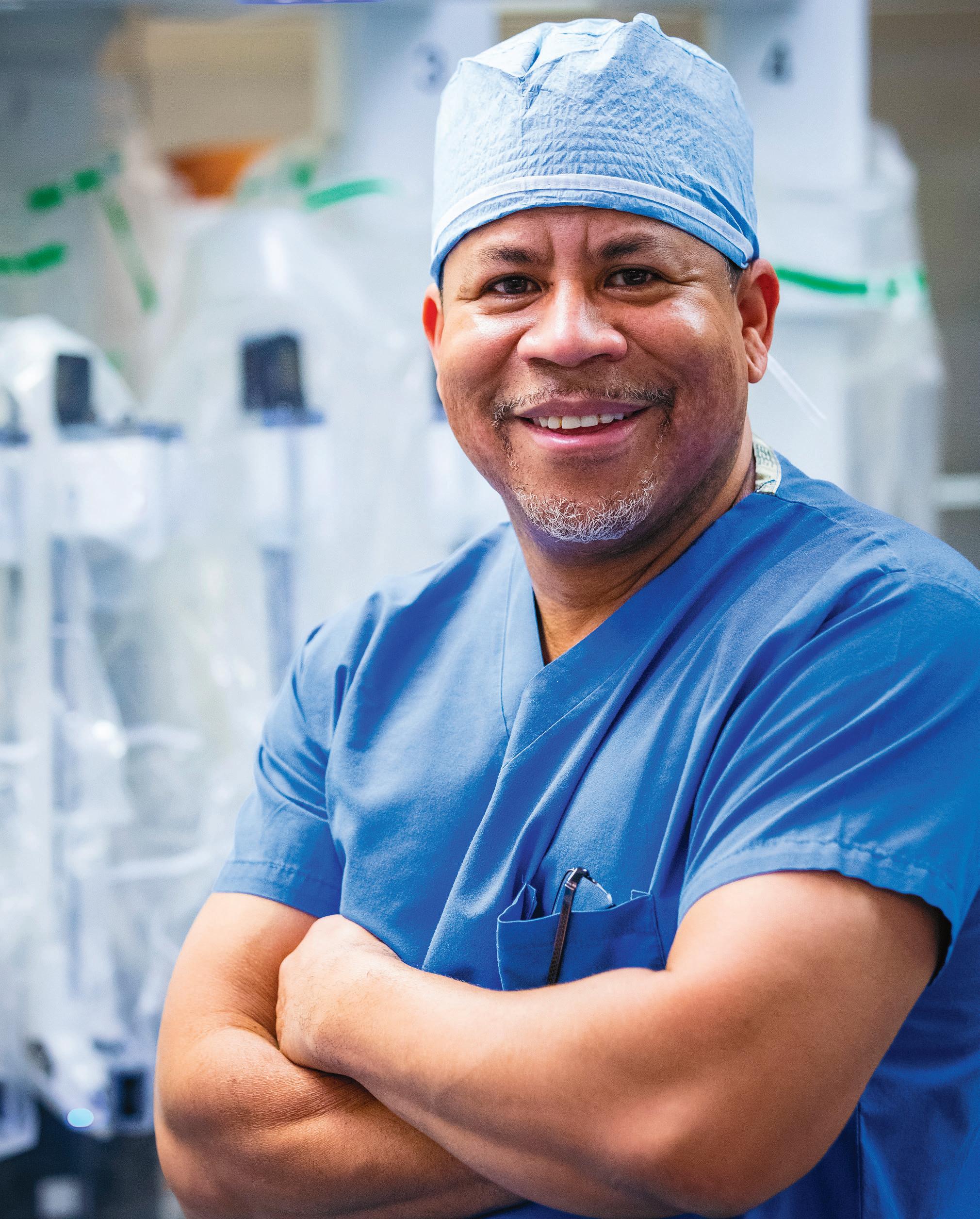
Dr. McCain is extensively trained in the latest most effective resection techniques, including robotic resections for gastric and colorectal cancer, and minimally invasive resections for pancreatic and liver cancer. Dr. McCain works alongside specifical nursing staff, and works collaboratively with medical and radiation oncologists at the John Theurer Cancer center to develop a treatment plan for each patient. Donald
Friday






OUR GUIDE TO NEW IDEAS, TIPS, TRENDS AND THINGS WE LOVE IN OUR COUNTY.

Labor Day signals the end of summer and the beginning of backto-school blues, but there are plenty of events throughout north Jersey to enjoy before the long weekend is over:
• Music in the Night, Friday, Aug. 30, Ridgewood business district. Soak in the sounds of live music as you stroll around the village’s business district while browsing in stores and dining al fresco. Musicians will perform at various locations, including Van Neste Square. See: ridgewoodguild.com
• Saint Joseph Society Feast, Friday, Aug. 30 to Monday, Sept. 2, 40 Spring St., Lodi.
It’s the 109th anniversary of this summertime tradition. The fair features food, rides, games and live DJs. Admission is free, rides and games are extra. Visit saintjosephsociety.org for the full schedule and times.
• Dumont 5K, Saturday, Aug. 31, Dumont High School. The annual 5K around town raises money for Dumont families in need. Besides the 5K race, there are options for a 1.5mile run/walk and a half-mile
kids’ run. Trophies will be awarded to top finishers in several categories. Registration is $35 for the 5K, $30 for the run/walk and $25 for the kids’ event.
Signup: runsignup.com
• Dom Mircovich Memorial 5K, Sunday, Sept. 1, downtown Closter. Now in its 43rd year, this event is one of Bergen’s longest-running races and the oldest in the Northern Valley. The course is flat (ahem, break a personal record, perhaps?), and prizes will be awarded to top finishers in several categories. Online registration is $20 for the 5K and $10 for the kids’ fun run.
Signup: runsignup.com
• Labor Day Street Fair, Monday, Sept. 2, Newark Pompton Turnpike, Riverdale.
Head here for one of the area’s largest street fairs, a favorite of many Bergen residents.
Browse more than 100 exhibitors’ wares and enjoy live music, fair food and kids’ activities. See: jcpromotions.info
The end of the season always puts us in the mood for change. How about changing up your dinner menu with these recently opened spots?
Here and now
Named with the Italian term for “right now,” Ora in Oradell opens with a philosophy that embodies just that. The proprietors say they offer “a full examination of Italian cooking, but viewed through the lens of what’s happening now in American cooking.” Everything is fresh, everything is local and everyone will find something to love.
• Ora, 304 Kinderkamack Rd., Oradell, 201.267.4304; orainthedell.com
Step into history

Maybe the big family vacation has ended, but that doesn’t mean the end of summer fun. Why not fill the weeks remaining before Labor Day with day trips and exciting activities? For instance, take a New York Waterways ferry from Port Imperial across the river. Now through Sept. 2, all kids ages 12 and under can ride the ferry free (with a fare-paying adult). Once you’re in NYC, choose one of the free shuttle buses to get to your favorite location. Pro tip: Check your local library for a museum pass granting free or discounted admission to the Museum of Modern Art, the Guggenheim, the Intrepid Sea, Air & Space Museum and other attractions.



Operated out of a rustic structure built in the 1700s, Tenafly’s new Spring House sets a high bar for itself. A combination of restaurant, bar and social club, it’s all about elegance and refinement. Check out appetizer options such as small lamb bites, entrées that include house-made pasta and a full dessert menu, plus an extensive selection of cocktails (with mocktail options), beer and wine.
• Spring House, 91 W. Clinton Ave., Tenafly, 201.353.0080; springhousetenafly.com
Expand your tastes
Add a stop on your culinary world tour: Uzbekistan. Old Bukhara opens a location in River Edge, offering Uzbek cuisine and authentic cultural ambiance to boot. Try out samsa—a savory pastry stuffed with meat and vegetables—or manti dumplings. You may just find your new favorite flavor.
• Old Bukhara, 606 Kinderkamack Rd., River Edge, 848.420.2222


If you’re looking to enjoy a day of fun, education and bonding with your little one, there are many “Mommy and Me” activities offered throughout the county.
Whether your child’s budding passion is music, dance or the water, you’ll find something to love at:
• Babies “R” Us Learning Studio, 1 American Dream Way, East Rutherford, 551.217.7711; babiesrusad.com
• British Swim School, 150 Sylvan Ave., Englewood Cliffs, 201.535.8666; britishswimschool. com
• Musical Munchkins of New Jersey, 55 George St., Allendale, 551.500.4887; musicalmunchkins newjersey.com
• My Gym, 522 S. Broad St., Glen Rock, 201.444.4644; mygym.com
• Take Me to the Water Swim School, 401 S. Van Brunt St., Englewood, 201.530.7200; takemetothewater.com
• The R Child, 2024 Center Ave., 2nd floor, Fort Lee, 201.499.7178; therchild.com




Garfield Middle School, for receiving a Purple Star for its services to military-connected students.
Garfield is the only middle school in Bergen to offer a Blue Star Kids Club for students with immediate family serving in the military. This club offers a community of support for these students, taking them on trips, doing services for veterans and sending notes to active military members.
Ben Shue, a rising senior and discus thrower at Bergen Catholic High School, named the 2023–2024 New Jersey Boys Track & Field Player of the Year by Gatorade for his athletic accomplishments. Shue also won the 2024 New Balance National Championship and the 2024 New Jersey state championship in the discus and placed second at the Track & Field Nationals in shot put.
Conor Campbell, an Englewood Cliffs resident and student at The College of New Jersey, who was the recipient of ESPN’s 2024 Billie Jean King Youth Leadership Award. A 2023 graduate of Bergen County Technical Schools in Teterboro, Campbell has dedicated more than 300 hours to advocating for youth access to affordable athletic opportunities, particularly for kids in Trenton. The award was presented at the annual ESPY Awards, held in July in Los Angeles.


Food trucks have become a staple of festivals and outdoor get-togethers—what’s not to love about great food to go? Besides being a fantastic destination for these on-the-go restaurants to park in, our county has an expansive selection of home-grown food trucks:
—The truck: RainBao, based in Teaneck. The cuisine: Chinese bao buns with innovative fillings such as jerk chicken, grilled cheese, a Jersey breakfast spread or s’mores. Many creations offer a Southern twist, as head chef Danielle is from Alabama. Where: The truck is often parked around Milton Votee Park in Teaneck, but also can be found at events all over north Jersey. See: rainbaofoodtruck.com
—The truck: Rolling Pita, based in Wyckoff. The cuisine: Mediterranean favorites such as gyros, humus and falafel. Where: This truck makes its way all over the state—you might catch it as far away as Monmouth County. However, it always ends up back on home turf. Watch for it in Paramus and Teaneck, and check its website: therollingpita.com
—The truck: Magic Mike’s Smoked Meats, based in Teaneck. The cuisine: “Teaneckstyle BBQ” (that’s what we call local pride!), including pulled pork, chopped brisket and smoked mac n’ cheese. Where: You may find this truck around the Meadowlands in East Rutherford, but Magic Mike’s truly lives up to the food-truck legacy—it’s always on the move. Be on the lookout at outdoor festivals and street fairs, and follow its constantly updating social media for more. See: magicmikessmoked.com
—The truck: Kimchi Smoke BBQ Shack, based in Ridgewood. The cuisine: American barbecue meets Korean barbecue. Enjoy Texas brisket and Southern fried ribs, or try Korean BBQ wings with a side of Korean slaw, kimchi or collard greens. Where: There’s a brick-and-mortar location in Ridgewood, so you can drop by any time, but the food truck is always on the move in Bergen. Keep your eye on events in Paramus, Rutherford and Hackensack. See: kimchismoke.com
Dog: Teddy, 2-year-old Sheltie/Pomeranian mix
Owners: Arleen and Frank Graham of Teaneck
After losing their two Shelties within three weeks, the Grahams didn’t think they’d be opening their hearts to another dog. But, between those Shelties and a set of collies before them, they’d had a canine in the house for more than 37 years. They couldn’t get used to the absence, so the quest for their new family member began. Though Arleen and Frank began looking for purebreds, none were available. The pup that was? Teddy, who had a birthdate listed as May 25, the day the couple lost their second Sheltie. Obviously, it was fate.

Teddy has boundless energy. So much so, in fact, that the Grahams are working with a trainer to channel some of it into fun and constructive agility exercises. Arleen also describes him as “affectionate and playful,” and says the pup reminds her of their old collies in a way that melts her heart. He is a dedicated watchdog and a wonderful daily companion. “We are so glad that we broke with our previous ‘only purebred’ tradition,” says Arleen.
Want your pet to be featured in an upcoming BERGEN issue? Email a brief description of your animal and his or her picture to Editor Rita Guarna at rita.guarna@wainscotmedia.com.

If your athletic routine is wearing thin, there are five sports just waiting to afford you new fun and new victories. Consider:
• Archery. Inspired to hit the target like an Olympian?
In Bergen County, there are several ranges and schools that can teach students of all ages the ins and outs of archery. The sport can help people develop hand-eye coordination while boosting confidence and self-esteem.
—Where to play: Campgaw Mountain Archery Range, 200 Campgaw Rd., Mahwah, 201.327.3500; Shooting Zone, Hackensack, 201.440.1329
• Bocce. This game dates back to 18th-century Italy, but it’s enjoyed a recent resurgence. Bergen held a countywide tournament for residents a few years ago, and many towns, such as Mahwah, hold seasonal bocce programs.
—Where to play: Lyndhurst Municipal Park, 310 Pine St., Lyndhurst, 201.804.2457; Pinstripes, 1 Garden State Plaza Blvd., Paramus, 551.966.0420
• Disc golf. It’s tough to control a golf ball’s slice off the tee, but maybe you’ll find throwing a Frisbee in a straight line an easier task. The object of this sport is to throw a disc into a basket or target using rules (and a large open course too) that are similar to golf.
—Where to play: Campgaw Mountain Reservation, 200
Campgaw Rd., Mahwah, 201.327.7800
• Pickleball. Think of this sport as a combination of tennis, badminton and ping pong. The racquets are slightly larger than table-tennis paddles, and games are played on a surface that resembles a tennis court, but is smaller. Whether you challenge an opponent or engage in a doubles match, the action is fast, and the fun plentiful.
—Where to play: Overpeck County Park, 40 Fort Lee Rd., Leonia/Ridgefield Park, 201.336.7275; Bergen Pickleball Zone, 50 Spring St., Ramsey, 201.825.2036
• Table tennis. If pickleball’s mashup of racquet sports is too complicated, start with this one. The rules of table tennis haven’t changed since your childhood pingpong days, but the games will be more competitive as you face opponents who’ve mastered spins and angles. For those not ready for real-life competition, some venues (such as the two below) have table-tennis robots that can help you practice in simulated games.
—Where to play: K Ping Pong Club, 229 W. Shore Ave., Bogota, 201.655.5379; Ready to Golf, 3 New Bridge Rd., River Edge, 609.388.7728




What with schoolwork, athletics, clubs, jobs, family obligations and socializing, it’s amazing that teenagers have time to do anything else. Some, though, actually make a difference:
• Rising senior Lucia Martinez-Pelaez of Tenafly High School is deeply involved with the League of Women Voters of Northern Valley, focusing her efforts on educating young people on the importance of civil involvement through school and library presentations. Before that, she was a representative for her high school class in student government and was voted by her class to be its Board of Education representative. For this engagement, the League offered her an internship, through which she hopes to combat low voter turnout all over Bergen.
• Twelve Midland Park Public School sixth graders participated in the CTC Academy Fair Lawn Buddy Program during the 2023–24 school year. CTC, formerly the Children’s Therapy Center, is a nonprofit that aids children with special needs. It pairs up one of their students with a student from Midland Park and sets up visits between the two to build connections. Together, the students worked on projects and eventually created a vlog together, which the was screened at CTC’s annual gala.
• Sachin Durgam, a rising Tenafly High senior, dedicates much of his time to mental health advocacy for teens in Bergen and beyond. Durgam has advocated for the establishment of a mental health library in Sunnyside Park before the Tenafly town council, in addition to starting the international organization remindful.io with the mission of improving mental health resources for disadvantaged teenagers.
• Five members of Scout Troop 7 are rising to the rank of Eagle Scout. Only 8 percent of Scouts nationwide make the rank, and each candidate must complete a community service project to do so. Four attend Ridgewood High School: Jaywu Jun built planter boxes at Ridgecrest Senior Housing; Robert Edward McCabe built benches and planters at Ridgewood’s Our Lady of Mt. Carmel Church; Joshua Nosrati Fishkin provided shelves and books for K-1 classrooms at Paterson Charter School for Science and Technology; Read Philip Hamon built benches and wood holders for the fireplace meeting area at Kearny Scout House. Finally, Tej Mistry Patel of Bergen County Academies in Hackensack created a stepping-stone pathway at Thielke Arboretum in Glen Rock.

Since opening in June, New Concepts for Living’s Achievement Center in Paramus has been ground zero for providing special-needs adults the care and the opportunities they need—and deserve. A spacious Main Street and walking paths, life-skills and training rooms such as a grocery store and a kitchen, spaces for recreation and wellness—all of these and more are set up in the former Barnes & Noble building on Route 17 South.
Calling it a “place with purpose,” Mayor Christopher DiPiazza says the community has anticipated New Concepts’s arrival. “Residents are excited to have a place like this here in town,” he says.
For Kim Catalfamo, mom of an adult child with cerebral palsy and multiple special health and other needs, the new center gives easier access to much-needed programs.
“With not enough programs available and long waiting lists, parents of adults with special needs often struggle to find a safe and enriching place where their children can get the services and support they need,” she says. “I’m so glad New Concepts for Living has opened this beautiful, comprehensive Achievement Center, which ensures that more and more adults with intellectual and developmental disabilities have access to critical services.”
Catalfamo continues: “[They have] a full calendar of activities for sharpening life and academic skills as well as art and exercise.... We’re so blessed to have New Concepts for family as part of ours. This is a great, great place!”
Nothing says summer like s’mores, one of the quintessential desserts of the season. And, in Woodcliff Lake this season, the Godoy family—Jimmy, Simone and their children Gio and Nathy—celebrated more than just the warm weather, as Jimmy explains. Nathy, their daughter, recently returned from spending time abroad in Brazil.
“We gathered around the fire pit to enjoy that beautiful evening with the loved ones,” he explains. Jimmy snapped a few pictures of the scene and posted them to Instagram with the caption, “Enjoying the nice weather with my favorite people.” See more great photos from around Bergen County in our Bergen Buzz e-newsletter. Visit bergenmag.com to subscribe—it’s free!

Photo courtesy of @american_finances101

Life is more complex for high schoolers than it was a generation or two ago. But there’s one constant in teenage life: kids hanging out together. When BERGEN gathered 12 rising seniors to talk over the issues they face (see page 26), we asked them about their favorite gathering places with friends.
Shopping was cited as a popular activity, with Bergen Town Center and Tice’s Corner among the favorite spots. An even more beloved pastime was eating. “Most of our hanging out consists of eating,” says Cliffside Park High School’s Stephanie Lack. She and her friends frequent a sandwich shop in town called Sarge’s.
For Northern Highlands’s Autumn Chiu, eating at Masago Sushi in Ridgewood is a ritual. “We go religiously,” she says. “The waiters know us on a first-name basis.”
Eva Zazzali of Academy of the Holy Angels says she and her friends visit Wegmans in Montvale often, while Bella Amato’s crew from Paramus High School goes to Bluestone Lane in Bergen Town Center and, of course, the local Starbucks and Dairy Queen. “I’m a Blizzard girl,” she says.
“We’ll kind of just go and have fun and be in each other’s company,” says Kaelyn Brisby of Mahwah High about her friend group. “It’s just nice to be around them, even if it’s for errands, going to the post office and then the bank and then to pick up a package,” adds Natalie Spitzer of River Dell High School.































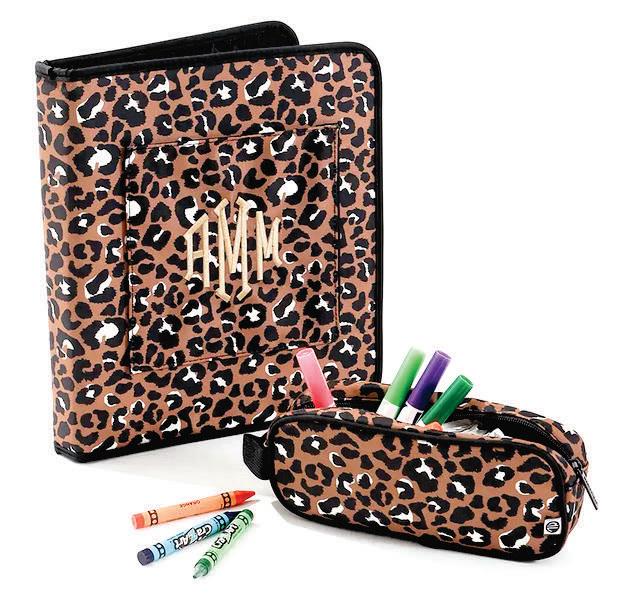

Whatever you’re facing, it’s easier to shoulder when your burden is shared. So, when you need care, know that there’s a place where care rises to another level. Where medicine can only be described as leading-edge. And where great hearts and minds come together to create hope, ease fear and give you the support you need mind, body and spirit. The name? Holy Name. Where providing great medicine isn’t a goal. It’s a religion.
When Teaneck’s Angela Logan needed to make some money fast, a recipe came to the rescue.
Teaneck’s Angela Logan inspired women the world over with her mission to save her home by baking and selling 100 apple cakes in just 10 days, as portrayed in the 2014 film Apple Mortgage Cake. She’s opened her own Teaneck bakery, launched national delivery through Goldbelly with new products and even made Oprah Winfrey’s 2023 list of favorite things. Now 70, Logan is determined to keep on inspiring—and not just during August’s National Black Business Month. Still on her bucket list? A “house of culture and cuisine.”
In 2009, when you sought to sell apple cakes to raise the money to save your home, what was the biggest obstacle you faced? Telling people I was about to lose my home. What gave me the courage to admit it was something I’d told my children when they were growing up: “Don’t ever be embarrassed because you don’t have something.” I asked the kids, “What would you think if I sold these cakes to help me save my home?” and the kids said, “Yeah, Mom, these cakes are great.” That really helped. Tell us about your grandmother, the late Melissa Bell, and her recipe for apple cake. Actually, my grandmother did not give me the recipe for that cake. It was another grandmother in Kansas who baked an apple cake. I tasted it. It was amazing. She gave me the recipe, and I started baking it. I made about 11 changes to make it like things my grandmother baked.
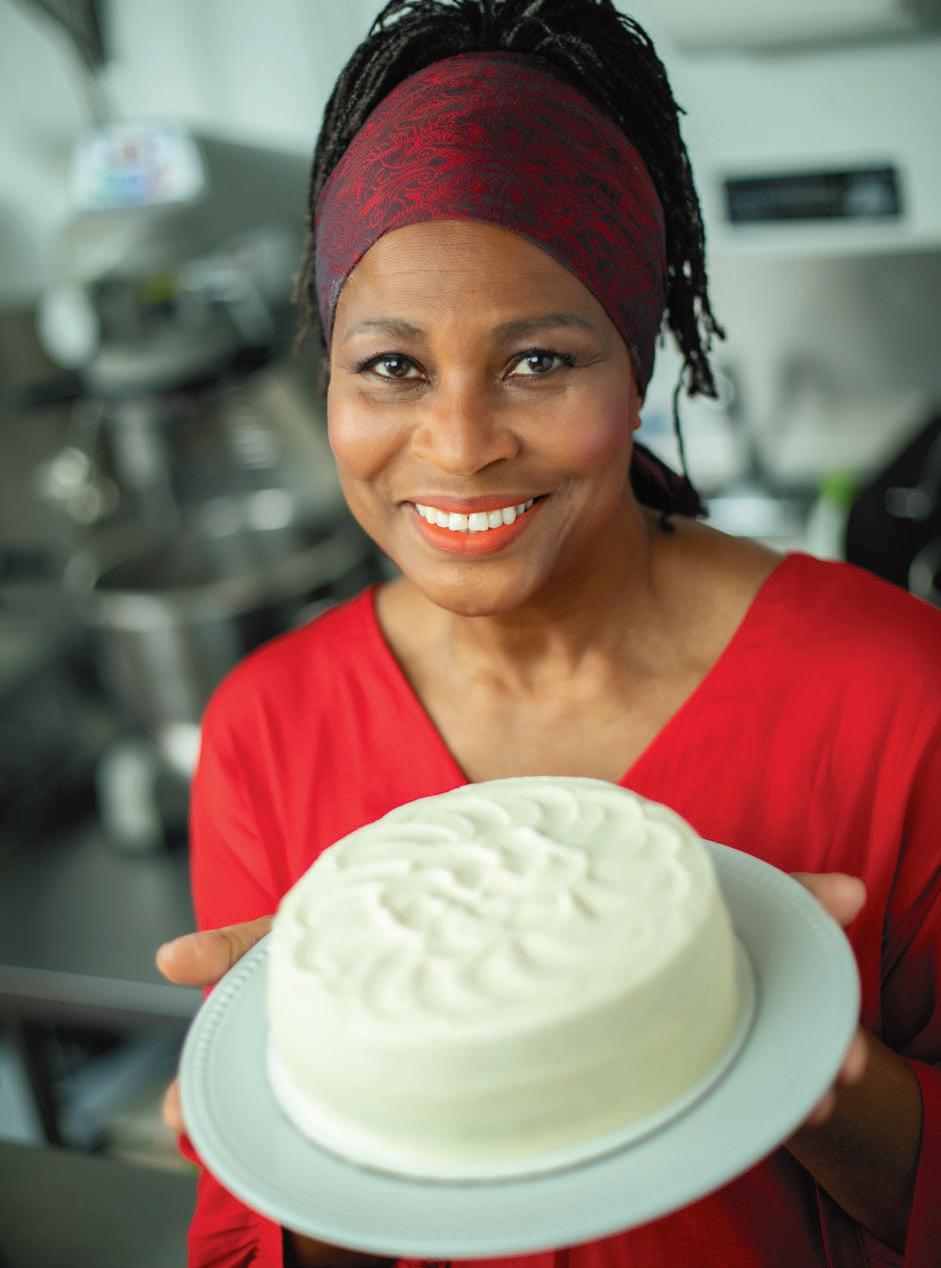
We were doing only farmers’ markets. We didn’t have a base, and we needed one for people to know where our product was.
And now word of your achievement keeps spreading.
The movie is still running. Whenever it runs, people buy cakes, and they call me. It doesn’t matter what time of day or night, I always answer.
So your grandma did serve as an inspiration? She had a big garden in the back and made everything from scratch. She was like the quintessential pioneer woman. She could do anything in the house, including the electrical. She was a survivor, and she was the woman I modeled my baking after, because she was a pioneer. How has life changed since the movie? It allowed me to open up a bakery [Angela Logan’s Mortgage Apple Cakes Bakery & Café in Teaneck].
What about the Black community?
I’ve been driven to stay open because there was a woman on a TED talk—a Marjorie from Chicago or Detroit, I think—who talked about the importance of being a presence in the Black community, because the money in our community doesn’t stay there.
How have you branched out?
One of my cohorts with Goldman Sachs, which helps to build your business, said, “Why don’t you
check out Goldbelly?” It’s an artisan e-commerce food company. That was a boost to our company, just being able to sell through Goldbelly—and then in 2023 we became one of Oprah’s favorite things.
How has your business involved the entire family?
All my sons have helped me, and Melvin, my fiancé from the movie, he’s been with me—we are partners in this game. Nicolas, the youngest boy, has helped me with new recipes. He graduated from Johnson & Wales University, and he’s an incredible culinary artist. Another son, William, is a 3D animator with an international film company. He helped with videos and photography. The third, Marcus, helped financially. For example, when we got this place, the ceiling was falling down, and he helped us to fix it. Tell us about your pre-bakery life.
I was an actress and did stand-up comedy. That’s how I met Melvin, at a comedy competition. I did a lot of TV commercials.
The biggest one was Night of Olay—it was in magazines and in commercials for years. And I did Law & Order: Special Victims Unit a couple of times.
What about your younger days?
I was in the Mid-Atlanta pageant when I was 17 or 18, and I was best all-around student in Georgia because I ran track, played basketball. I went to Spelman College [in Atlanta] and then Michigan State, where I was a dance fellow and assistant director of dance. I came to New York and started modeling and acting. Oh, and I was a choreographer for the [NBA] Detroit Pistons’s first dance cheer squad.
Describe the “house of culture and cuisine” you’d like to open.
It would show how the Southern culture entered our cooking, dancing and music. I love banjos and fiddles and guitars. I love folk singing and dancing like the Virginia reel. I want all of that in the house of culture and cuisine.
—Donna Rolando
by William Frazier






Researchers have found that women in their 70s were less likely to be unhappy with bodies than their younger counterparts.
—University of North Carolina at Chapel Hill



Walking reduces levels of the hormone cortisol, which surges during stressful events. High levels of cortisol may contribute to Alzheimer’s disease, but just a 20-minute walk has been shown to reduce stress.
—Frontiers in Aging Neuroscience
considered pressure. But that lowering number) reading is sodium intake to per day is one
—JAMA Cardiology

Overweight people had 4 percent brain volume than folks of normal weight. The brains of obese people had 8 percent volume and their brains appeared 16 years older.
—University of Pittsburgh and UCLA
—Compiled by Paul Rance Jr.

Researchers have known increases the risk of they weren’t sure why. been discovered that accumulate in the lungs. addition, more fat has found in those people with a higher bodymass index. The fat causes inflammation, thickening airways, which makes breathing more difficult.
—European Respiratory Journal
Spaces, that is. Research has found that children growing up without green spaces had a 55 percent greater risk of developing psychiatric disorders than kids exposed to verdant areas.
—National Academy of Sciences

















IF THE BLACKBOARD IS A BLUR THIS FALL, TROUBLE LIES AHEAD. BUT REGULAR CHECKS WITH AN EYE-CARE PROFESSIONAL CAN HELP.

One in four U.S. children ages 2 to 17 wears corrective lenses, according to the Centers for Disease Control and Prevention. And other kids ought to be wearing them but aren’t—yet. Vision problems at an early age can adversely affect how a child learns in the classroom and interacts with other students, and they’re also a safety concern.
As we observe national Children’s Eye Health and Safety Month, eye specialists like ophthalmologists and optometrists, such as NJ Eye and Ear in Englewood and Bergen Optometry in Hackensack, can guide parents as kids prepare to head back to class in September:
• Recognize symptoms. Let’s face it—some kids, especially the youngest ones, may not communicate that they’re having trouble seeing, either at home or in the classroom. They may be embarrassed to say they can’t see properly, or they may not even realize that their vision isn’t clear. Vision problems in children aren’t always obvious so it’s important for parents, teachers, brothers and sisters to closely observe kids as they’re growing. Parents should be on the lookout for symptoms such as squinting or holding reading materials very close to the face. They can be subtle indicators of impaired vision, but they’re frequently missed signs. Blurred vision can also be accompanied by frequent headaches, a short attention span and coordination difficulties.
• Get kids tested. Just as you’d take your child to a pediatrician for a back-to-school checkup, take her or him for a routine eye exam with an ophthalmologist or an optometrist. Many parents believe that school screenings are the same as comprehensive eye exams, but even with 20/20 vision, your child may still have problems that can only be detected by an experienced eye doctor. The American Optometric Association recommends that kids receive their first eye exam between six and 12 months, followed by another exam at three years, then exams every other year while they are in school. Kids with impaired vision often have one of three conditions: myopia (nearsightedness), hyperopia (farsightedness) or astigmatism (partial blurred vision caused by
imperfect curvature of the eye). Other common eye problems are amblyopia, or lazy eye, and strabismus, when the eyes are not properly aligned. Eye doctors can recommend treatment or correction for each of the conditions.
• Choose correct correction. In most cases, children with impaired vision will be fitted for glasses. (Parents can have fun with kids by letting them pick out their frames!) For older kids, especially those who play sports, contact lenses are another correction option. Children as young as 8 years old can do well with contacts, but it’s really up to the parents and the patient, as daily placement of the contacts on the eye—which includes keeping lenses and hands clean—and regular maintenance require a high level of responsibility. That said, most eye care providers won’t recommended contacts for children younger than age 12, as the risks often outweigh the benefits in younger children. Meanwhile, your child’s celebrity idol may tout the benefits of corrective eye surgery, but procedures such as Lasik are not FDA-approved for patients under 18. Goonetilleke notes that because the cornea can still be in a developing stage even in a patient’s late teens, most eye-care professionals won’t recommend surgery until a person reaches 21.
• Be wise with kids’ eyes. Eye care goes beyond correcting impaired vision, and it’s up to a parent or guardian to ensure that kids are maintaining proper health to keep sharp. Children should take regular breaks to prevent digital eyestrain. Keep in mind the 20-20-20 rule, which suggests that an individual look at something 20 feet away for 20 seconds every 20 minutes. This practice can help reduce eye fatigue and keep eyes healthy. Prolonged exposure to ultraviolet lights has been linked to ocular disease later in life, so most experts recommend that children wear sunglasses as part of their regular outdoor protection routine. Protective eyewear also is recommended when kids play contact sports or sports involving potentially sharp equipment. Parents should also limit a child’s exposure to household chemicals, detergents and cleaners, many of which can irritate eyes.
If you’re looking for a diet that is good for ocular health, the American Academy of Ophthalmology recommends emphasis on:
• Orange-colored vegetables for vitamin A: carrots, sweet potatoes, cantaloupe, apricots
• Fruits and vegetables for vitamin C: oranges, tangerines, grapefruit, lemons, peaches, red bell peppers, tomatoes, strawberries
• Leafy greens: spinach, kale, romaine lettuce
• Foods rich in vitamin E: avocados, almonds, sunflower seeds
• Fish with omega-3 fatty acids: salmon, tuna, sardines, trout
There are several types of eye doctors and specialists who can help you with your vision. Before you go, it’s important to know the differences between each expert. Here’s a quick guide:
This specialist is a medical doctor (M.D.) or a doctor of osteopathy (D.O.) with advanced eye-care training who offers complete eye care, from exams to diagnoses of diseases. In addition, an ophthalmologist is licensed to practice medicine and surgery and can perform surgical care for issues such as cataracts, trauma, childhood eye conditions and glaucoma. When to see one: general eye care, management of eye diseases and conditions, medical intervention
Also a doctor of optometry, this specialized clinician has additional training through residency programs focused on eye disease and conditions. They can provide complete eye care but primarily focus on medical care for eyes, assessing eye health, monitoring and diagnosing diseases.
When to see one: general eye care, annual medical eye exam
This professional is a doctor of optometry (O.D.) known for expertise in providing vision correction and care, though they also can diagnose, treat and manage eye diseases and disorders. When to see one: general eye care, eye checkups, vision tests and eyeglass or contact lens prescriptions
These technicians trained to design, verify and fit eyeglass lenses and frames, contact lenses and other devices to correct eyesight. They use prescriptions supplied by ophthalmologists or optometrists.
When to see one: glasses and contact lens fitting
Sources: New Jersey Department of Consumer Affairs and American Academy of Ophthalmology
Panicked about today’s teens? This year’s BERGEN conversation with 12 rising high school seniors shows them to be thoughtful and articulate—if also, like, a little worried. BY RITA GUARNA
OUR FORUM MEMBERS:
Bella Amato, Paramus High School
Isabelle Bertussi, Immaculate Heart Academy
Kaelyn Brisby, Mahwah High School
Autumn Chiu, Northern Highlands Regional High School
Canon Chiu, Northern Highlands Regional High School
Elizabeth Davis, Waldwick High School
Hunter Ditrano, Don Bosco Preparatory High School
Stephanie Lack, Cliffside Park High School
Devin Ryan, New Milford High School
Natalie Spitzer, River Dell High School
Liam Tenenbaum, Tenafly High School
Eva Zazzali, Academy of the Holy Angels
Adolescence is about, like, tentativeness. When teenagers pepper their speech with “like” (with a frequency they’d never use in, like, a paper for English), it’s more than a shared conversational tic. Quite plausibly it’s a verbal nod to tentativeness, a habitual gesture of social humility conceding that the words that follow may not be perfectly chosen, and assuring hearers that any blunt truth that may next pop out of the mouth isn’t intended as a hurtful micro-aggression. It’s just that life is full of, you know, stuff, and some of it is, like, awkward.
up with high schoolers today, what’s up with social media and competition and parental pressure and overburdened schedules and sports teams and highpowered academics and drugs and cheating and school safety and that constant obsession of high schoolers in any era, the capital-F Future.

MODERATOR:
Of the 434 original instances of the word “like” in the uncorrected transcript of BERGEN’s seventh high school forum, our editing has left in many (but far from all). That’s because that’s how kids talk. Also, we believe the feeling of tentativeness that commonly interjected syllable implies is part of the story we seek to tell—the story of what’s
Rita Guarna, Editor In Chief, BERGEN Magazine
Our 12 forum members are no typical cross section; they skew toward class leaders, schoolroom standouts and playingfield achievers.
They have the good manners you’d expect of such presentable proto-adults, but when you cut through the extraneous words and the polite mutual agreements they don’t let those manners stop them from actually saying things—sometimes bold and surprising ones.
After all, if you were starting out to face the world in its present condition as a high school senior, wouldn’t you feel, like, a little tentative too?




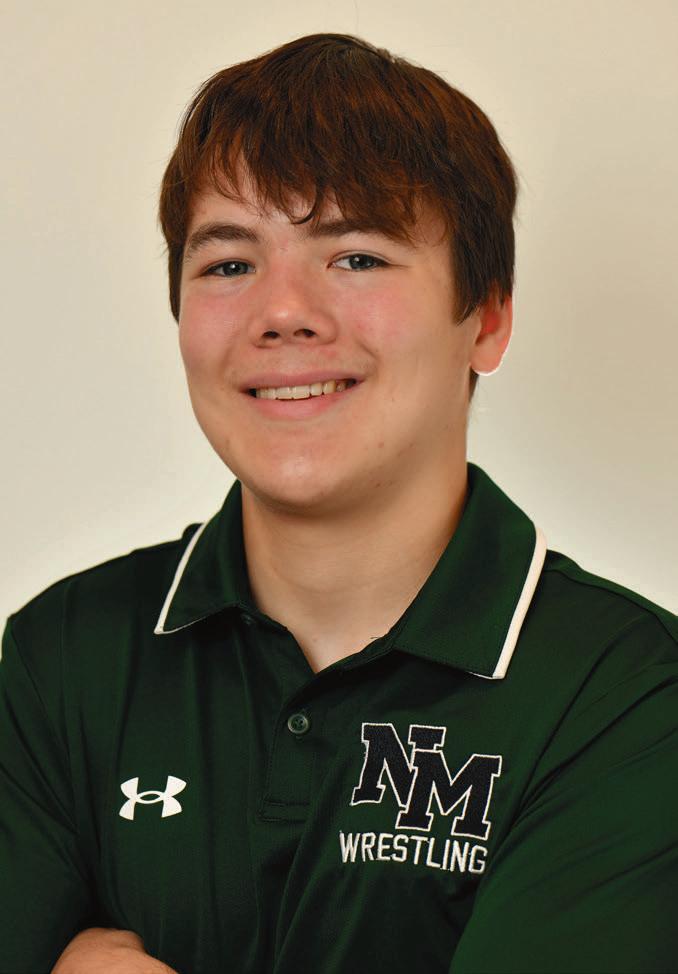
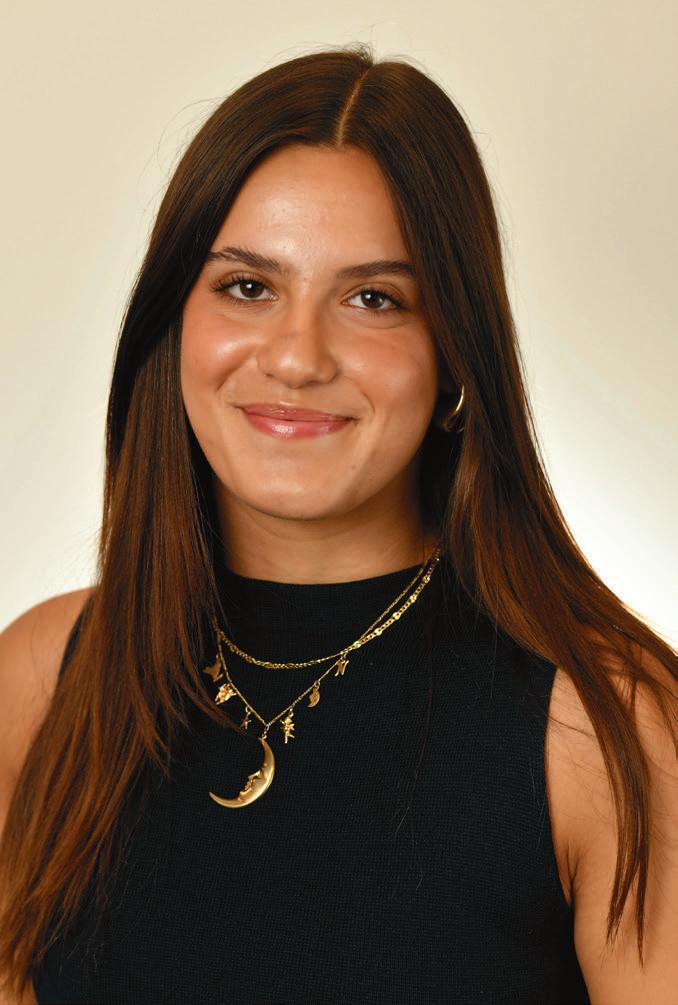

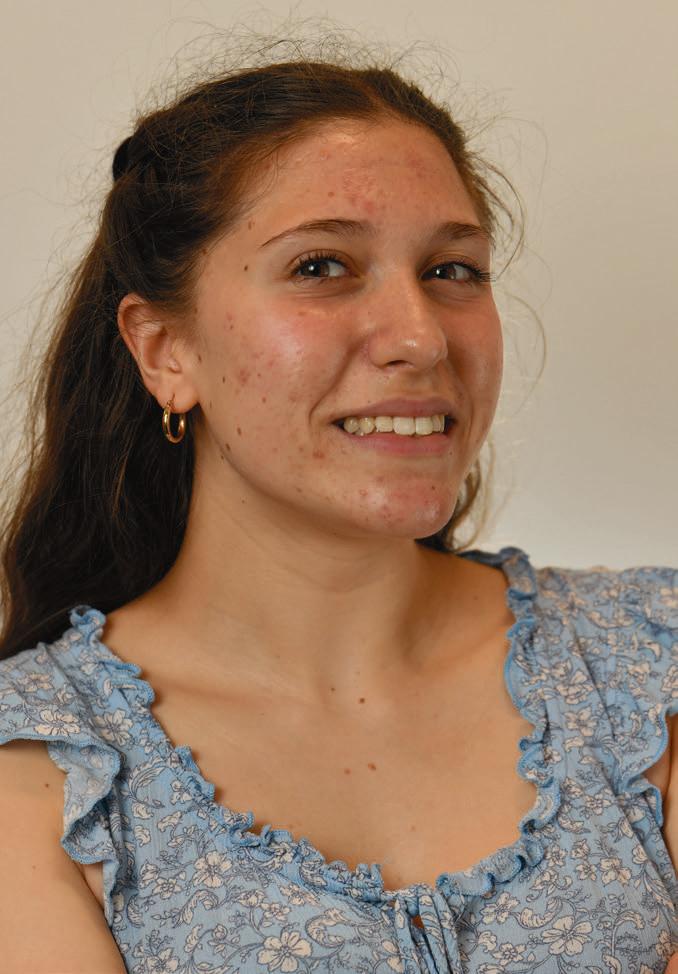

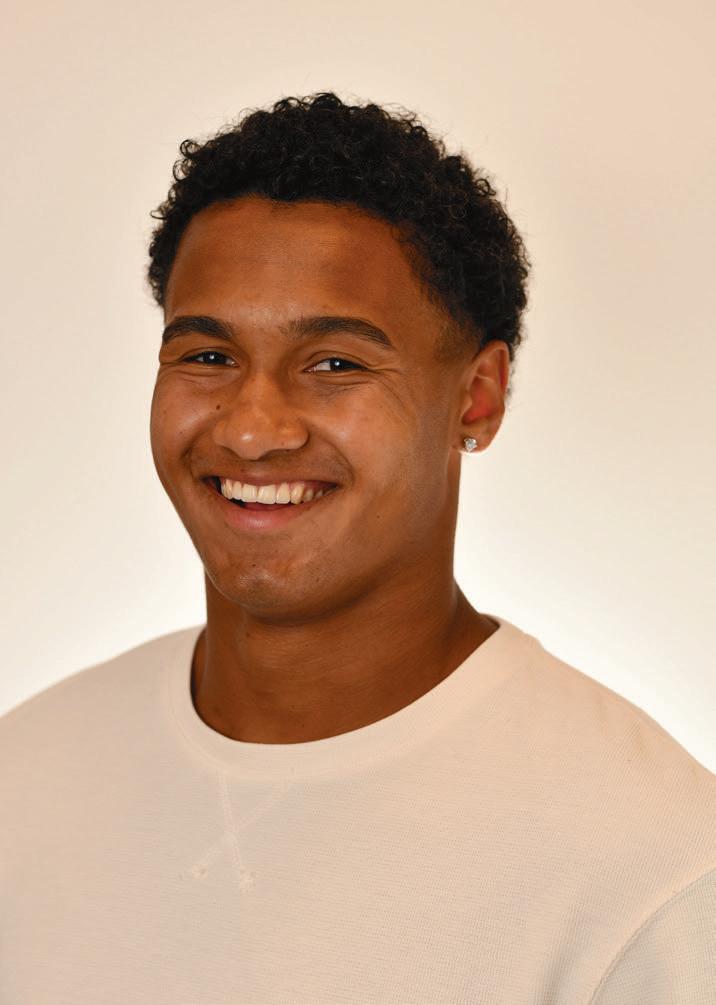


Rita: In the past couple of years, we’ve done our forum on Zoom. Before that we would meet as a group the way we are now. We want to know what is going on in your lives. In our survey, most of you answered that you think social media has a negative impact on your mental health. Can you expand on that?
Autumn: For people who easily fall for fake news or filters or certain aspirations that they think they have to be, that could be really detrimental to them, especially when people have a need to conform or if they’re not realistic.
Isabelle: It definitely has to do a lot with physical appearance. But also, social media is a highlight reel— it’s not everything that’s going on in a person’s life. It makes it really easy to compare what your life looks like—lifestyle, money, status, all these influencers, all these trips—and say, “Well, they have that, but I don’t!”
Canon: When Facebook came out against Myspace, one of the biggest differences for Facebook is that you were able to get a lot of people into your social bubble or, like, block them and let them out. That causes a lot of people to feel excluded. On Instagram or, like, Snapchat or private stories or private reels, you’re going to exclude a lot of people. That creates a general fear that, like, you’re going to miss out on something if you’re not always on social media, which causes a lot of mental health issues.
more hurtful for other people. So our school’s trying to prosecute the people who are, like, posting negatively. But it’s really hard because they’re anonymous.
Rita: Well, I was going to ask about prosecution. How do you if you don’t know who it is? But there are ways to find out, right?
Liam: My principal was telling me that he was trying to make an undercover account to, like, try to act like a kid to find out who they were. But it’s hard. He made it sound like it didn’t work. Anonymous accounts are really powerful.
Stephanie: It’s easier to limit it when you don’t interact with it. Because the more you do, the more someone can bully you. The bully wants the reaction. So on social media, like I feel like when it comes to like gossip and rumors, if you engage with the person, they’ll feed off the reactions. But if you just have, like, no comment, then you don’t, like, move yourself into it and you limit the way that it spreads.
Bella: About comparisons, I think that’s a really big issue with it now, especially with editing and not just photos—like, even after photos are taken, there’s a lot of editing done. And besides the mental aspect of it, I
getting upset. That reaction is what fuels their actions. The more they don’t get a reaction from anybody and it just kind of gets ignored the more they’re like, “I wish I hadn’t done that.”
Kaelyn: I agree. Even when I was little, my parents would always say, “People that bother you just want to get the reaction out of you.” They want that selfsatisfaction. So once you stop giving it to them, then the bully will kind of just be like, “OK, move on. I want someone else.” If it was super serious, that’s when you would go and talk to your guidance counselor or administration or something.
‘WE
Rita: Do you all have jobs?
Kaelyn: I did last year, but this year I’m a captain for soccer.
Rita: During the school year, how do you juggle academics, athletics, activities and jobs?
“I think you have to make a lot of sacrifices and you have to decide, like, what’s most important to you, because you can’t do everything. There’s not enough hours in the day to do it all. ”
— Natalie Spitzer, River Dell High School
Natalie: I agree. I think social media is really good in a way—you can share information and learn a lot. They can also have, like, very adverse effects. In my school, there’s rumors and there’s gossip not always good about other people. And sometimes that can spread, really, like wildfire. If the rumors are about you, it’s not good.
Rita: Are there ways you have found to protect yourselves?
Natalie: I think it’s hard, but just staying out of it, honestly, especially on social media. People take screenshots and so if you avoid that, I think that might help.
Rita: Do you agree with Natalie?
Liam: We actually had a virtual epidemic with this app called Fizz. It’s like an online forum where people can post about each other anonymously. I think it started on college campuses, like I think Stanford was the one that created it. Someone brought it to our school for money. And then what happened was, people started posting edited pictures of each other without any repercussions because, you know, the name is not included when you post. So that was a really big problem. Bullying was going on, like it was really, really bad because people added pictures with any sort of captions. So just like anything, social media can evolve to just become
do think there’s a physical health aspect of it as well, because it can ruin sleep cycles as well. It can turn into physical symptoms.
Rita: Well, so with all of this negativity that I’m hearing from all of you, why are we still engaging in social media?
Isabelle: It’s like our modern dopamine. I mean, once you start, like, you can’t stop, I guess. So also sometimes for me, like, I love Pinterest. Sometimes I use it as inspiration, not just comparison.
Eva: It’s also like the main form of communication. I tried, and for like three months I didn’t have any social media. OK, it was nice. It was also like you kind of feel, like, out of the way.
Rita: OK, that’s fair. One of you mentioned bullying. Do you see bullying?
Liam: [Fizz] made bullying so possible because you could post anonymously. I know it happens—it never happened to me personally. A lot of people talk about cyber bullying, and maybe you don’t realize how present it is, but when they start talking about it in our school, it’s like, “Wow, this is real.” It was happening to a lot of people, and a lot of people were complaining to the administration.
Devin: I feel like what gives a person power is the reaction that they get from it—their friends laughing along with them or, like, the person they’re bullying
Autumn: I actually don’t have a regular, clock-in job during the school year because I have a lot of different leadership responsibilities within the school. So I’m very involved in the fall, in the winter and in the spring, I don’t do any sport, if you will, but I do clubs. And I actually found that I was doing better in school in the fall, in the winter, because staying extremely busy kind of kept me going. When I find that I have nothing left to do, I kind of gravitate toward like relaxing or going on my phone. If I’m busy, you’re almost like too overwhelmed to even think about that so like you keep going. So, for example, marching band is a huge commitment, especially if you are on the leadership team. The rehearsals are three hours a day, twice a week. And on the weekends it’s like 12-hour days. So when you get home at, like, 10 p.m., you can’t even, like, relax. You just have to do homework. And I found that I did better because I was so focused.
Elizabeth: I say it’s very hard. I play multiple sports and then sometimes I have to go straight to work after, which can be extremely difficult. I can be gone from 8 to 10. That’s not including, like, homework and stuff. So it’s kind of figuring out what your priorities are. A lot of us probably don’t want to have regrets for our high school years, so figuring out, like, what you want to spend your time doing is a big part of high school for me, and probably others too.
Isabelle: I definitely agree. What do you want your high school years to be filled with? I just made, like, the very hard decision to stop playing my sport this year. I’ve been playing soccer since I was 5, and I just figured out this year that it’s not going to work out for my senior year because I have a lot of leadership positions. I called the coach and he was like, “I completely understand.”


Rita: Did you make this decision on your own or did your parents play a role?
Isabelle: It was mostly my decision. My parents fully support me and my decision. They kind of saw it coming, I think. I think I was the last one to figure it out.
Kaelyn: To go back to what Autumn was saying before about how when it’s really busy, like, you kind of program yourself to just go, go, go. That’s how I was. I was a tri-sport athlete for my freshman and sophomore years, and especially during the winter season it got really difficult and it really took a strain on my mental health because I was constantly tired. This past year, actually, I stopped playing my winter sport, and I found myself a lot happier because I was able to focus on my social life and school. It was a hard decision because my friends still did the sport.
Rita: And I guess if you start identifying yourself with a sport and it becomes part of who you are, that must be really difficult.


Natalie: I think you have to make a lot of sacrifices and you have to decide, like, what’s most important to you, because you can’t do everything. There’s not enough hours in the day to do it all.
Bella: During the winter season, I go straight from high school basketball to club soccer, and I have basically like an hour and a half in between. I have had two sports overlap. So having an overlap, you kind of have to decide which one. And more recently I found myself choosing soccer just because its potential options for college.
Devin: I’m kind of in the same situation: I wrestle for a club, and I also wrestle for my high school team, and they’re both in the winter. It gets pretty, like, packed with, my schoolwork, wrestling for the team and then wrestling club. I’ll go right after high school, practice, then another practice, and I won’t have that much time to, like, do homework and stuff like that. But it’s worth it to me because I love wrestling.
Hunter: I play football so it’s pretty rigorous all year
round. I was at practice this morning. It feels like a job, but it’s my social life. So it’s like I’m there with my friends, then I leave there, stay with them, go to their houses. It’s a lot harder during the school year because I’m out late. With that and school, I’m just trying to find a balance and get sleep and do my work.
Rita: Is there a lot of cheating going on in your school?
Bella: As the students get smarter with AI and ChatGPT; the teachers do as well. That’s kind of a constant back-and-forth. They find, like, a firewall or something to block it or at least to scan it over. And they’re finding new apps and new ways to, no pun intended, turn it in because they have to use these apps such as Turnitin to read our work.
Stephanie: As we get older, usually our classes get harder as well. So, like, cheating becomes just harder for you because if you cheat on something, then you have a test next week and then, like, your grade tanks.
I’m sure a lot of it’s like your grades are like such a priority and you don’t want to see that. So I feel like putting the effort to cheating just ends up being harder for you. But it doesn’t mean that you won’t do it. But like she said, you gotta talk to your friends about it.
Canon: I’ve seen a lot of, like, quid pro quo where people either trade tests, or they trade homework in passing periods because they don’t have enough time to study for those tests. There’s a bio group chat or a math group chat or a friend group chat. And one kid would just, like, spill all the answers to the group chat or post homework in exchange for other homework. I see that happen a lot.
Rita: Oh, wow, so it becomes a commodity.
Natalie: Yeah, and some teachers in the same period will give, like, five different tests.
Liam: It’s also a thing where as soon as you would finish a test, a bunch of people would come up to you and ask you what was on it. I remember my freshman bio class, people would walk out like Hollywood red carpet. Teachers can try to edit questions and stuff, but there’s still advantages to being in later periods. If you’re in a later period of the day after lunch, you’re almost guaranteed you get a heads-up that you’ll have a reading quiz, which was like a luxury. So, during lunch you can read SparkNotes or like, even, watch YouTube to prepare you more.
Rita: So do you all partake in this?
pressure to be at certain checkmarks. So even now it’s like you have to make sure you’re caught up so you can be ready for college and med school.
Eva: I’m actually applying to school for musical theater, which is like such a weird like thing. In addition to the college process you have to audition. It’s weird because a lot of people do theater, but I don’t think there’s anyone else going for it. There’s no traditional path to take. Social media is, like, such a big part of it. Any time you have auditions, they always ask for Instagrams, so you always have to keep up with your image in addition to grades and everything. It’s very untraditional.
Natalie: I’m in for classical music performance, like both my parents do. I know that’s not what I’m going to do but as I’m getting closer and closer, like, I kind of realized, “Oh, that means I have to stop.” It’s really stressful because it’s also not a real career path. And I’m grateful that I have my parents because that’s what they did. But it’s also hard to get guidance from outside because most people are not of that world. It’s really stressful.
Rita: So what instrument?
Natalie: Flute.
AI can’t replace. I can’t see myself in 15 years, because what if I open something that doesn’t go well and isn’t received well by the public?
Kaelyn: For high school students, like, there’s so many decisions that we have to make right now. OK, you’re saying, “What are you going to do with the rest of your life?” Like, decide that, go to college for and study for it, and that’s what you’re stuck with for the rest of your life. Obviously, you can make changes when you go to college, but I think it’s a lot of pressure to put on high school students that are, you know, 17, 18. When people come up to you, they’re like, “You’re a senior—where do you want to go to college? What are you going to do?” Like, that’s the question that I’ve been asked so many times already. There is a pressure to decide what you want to do.
Isabelle: Definitely there’s a lot of external pressure, but once you get asked that question enough times, it’s like, “Is it me?” I start to put a lot of pressure on myself, because I see a lot of peers committing already. And it constantly makes me feel like I’m behind.
Rita: Who are your role models? Influencers, parents, friends, teachers?
“I haven’t really made a decision. I’m thinking, like, I would like to be a doctor of some sort because I get to help people and I make enough money to support myself.”
— Devin Ryan, New Milford High School
Autumn: I know everybody feels differently about it, but I think a lot of students work so hard since your freshman year, since your first day of school, to build your reputation, to build your rapport with teachers. So at least for me, cheating is not worth it because I would rather fail a test than ruin that reputation. Because, like, building your reputation is kind of like putting little drops in a water bucket. You know, little drop, little drop, little drop. But one mistake, it all goes out. So the cheating thing—I don’t think it’s worth it.
Elizabeth: It’s like you’re putting yourself a couple steps back from your peers. I think, like, the only way to learn is sometimes to do the harder thing, and cheating is the easier way out.
Natalie: If you cheat and you get caught, that teacher will always not trust you. Even if you put in a significant amount of time studying, then you cheat and get caught, then like you just wasted that time. Even if you could have gotten, like, a 75, now there’s a zero.
‘A JOB AI CAN’T REPLACE’
Rita: What do you feel about the future job market, and what kinds of jobs are you thinking about?
Elizabeth: I would like to become like an OB-GYN. The medical field is very “you got to know what you want” if you want to be in it. That puts a lot of
Rita: How beautiful!
Devin: I just think it’s, like, hard to find the career path that you really enjoy doing and you’re going to make enough money to support yourself. I think that’s a big concern—things are getting really expensive nowadays. And it’s hard to decide, like, “OK, am I going to do this job that’s going to make me less money, but I’m not really going to be able to live comfortably? Or am I going to do this job that I’m going to be able to live comfortably, but maybe I’m not going to really enjoy it?”
Rita: So what did you decide?
Devin: I haven’t really made a decision. I’m thinking, like, I would like to be a doctor of some sort because I get to help people and I make enough money to support myself.
Isabelle: I think I know I want to start my own business—I’m not sure what kind.
Rita: That’s exciting. So you’re an entrepreneur? Isabelle: Yeah, exactly. But my dad owns a business, and I figured it’s a lot harder to run a successful business now than it was in the past, because it’s a very saturated market at this point. Like we were all saying, like, there’s no straight path, there’s no yellow brick road, so you kind of have to. There’s nothing like a business, right? There’s a business and there’s a medical brain. Is your brain wired differently? So I think that’s also a big thing with technology. It’s like, I have to pick a job I know
Devin: The people I look up to most are my coaches. They have a big impact on my life. Not only did they teach me how to play a sport, but they also teach me a lot of stuff about, like, how I should carry myself, what things I should consider important. Like, they’ve never told me that the most important thing in my high school career is winning a state title. They always preach to do my best, and treating people with respect and kindness.
Rita: Those are good coaches. Hunter, you play football. What about your coaches?
Hunter: I definitely look up to them; some are like father figures to me. I spend, like, my school career with them, all day in the summer, even in the school year a lot of them work as gym teachers. So during lunch they come to our table. I definitely look up to them; they relate to us and they’re always trying to build that connection. They focus on being good people and instill that through football.
Liam: I feel like my role model is my brother. I can relate to him a lot more. My parents are immigrants, and they’re all born in a very different decade than my brother. But my brother’s only a couple years older than me, but kind of does, like, everything just a little bit ahead of what I do. So I feel like whenever I’m struggling with something, he’s the first person I would turn to.
Rita: And there’s no jealousy? He’s taking the path ahead of you and telling you what’s ahead?
Liam: I feel like he definitely wants to give me advice. He’s always trying to help me out and he’s like, “Yeah,



when I went through something, I don’t want you to go through the same thing. I want you to, like, know enough so that you can do it the right way the first time.” I appreciate that.
Rita: What a good brother!
Bella: I do agree it’s easier to have someone closer to your age. For me, it’s been like older teammates, older friends who have just gone through what I’ve been through just like a year or two or three before. You can build off almost all their successes and their mistakes.
Rita: Are there attributes or character traits of these people other than telling you what’s coming?
Natalie: I would say I look up to my sister a lot. We’re twins, actually. We’re so different. It’s like we’re totally opposites, but she’s so driven, and she has a lot of integrity. She’s doing the same as me, but she’s putting everything into it.
Autumn: It’s kind of embarrassing, but Canon is a
huge inspiration for me. Like Natalie said, Canon has a lot of integrity, and he’s anxious in the best way. We have five classes together. So sometimes when I hear him waking up at 5 a.m. to study, I’m like, “Oh, my God, I got to study too.” I look up to a lot of people, not because, like, they have the same career I want to go into, or necessarily that they’re the same age, but mostly because of the philosophies they live by. I look up to my family members a lot. I look up to a lot of teachers and administrators in my school, because I see the way that they treat other people.
Isabelle: I come from an all-girls school experience. I think it’s very empowering to see all the girls, their approach on everything they want to do in their lives, and it’s very motivating. Like you were saying how driven everyone is—I think it’s very inspiring. There’s less comparison, more just like they make me want to work hard as well.

Rita: If you could change one thing about your high school experience, what would it be?
Elizabeth: Coming in as a freshman, I wanted to get involved in everything. I was spending my time with different things where I wasn’t going all in on one thing. I kind of wish I found the things I was passionate about, like the clubs, sooner so I could get more involved.
Rita: That’s interesting, but I guess coming back to what Bella said earlier, if you didn’t expose yourself to those things, you wouldn’t know the thing you were really passionate about, right?
Bella: If I could change one thing about my high school career, I would say putting energy toward things I can control, not the things I can’t control, because, like, studying for my exams, I can control that and I can do that myself.
Liam: There are a lot of different schools—their
student sections really had that spirit every sports game. I feel like our student sections are pretty weak, compared to Bosco’s or Highlands. Maybe when we’re really, really good at a certain sports season, people will show up and, like, support their friends. But generally, I just wish there was more of an initiative to get people into the stands and excited for games. Right now, it’s kind of a joke amongst students.
Bella: At our school we’re creating this thing called SALT (Student Athletic Leadership Team) with a person representing sports. They come together and they’re talking about ways to get more, like, equity in sports or more fans to games. So the eighth graders are more involved coming into their freshman year to get to like sports, and sports that don’t feel equal to others are still getting an opportunity to show their best strengths. Devin: I was just going to agree with Liam. At a small school, it’s really hard sometimes to get students together, and that kind of sucks. As an athlete, one of the best feelings is, like, looking out and seeing people cheering you on. When that’s not there, it’s not a great feeling.
Rita: Do you all feel accepted by your peers?
Isabelle: I’m going to say yes. At any school there’s going to be a level of competitiveness, but I think we preach the idea of sisterhood. Some people may think it’s a problem, and some people might think it’s a façade. But surely you see it every day, like it really like echoes through the halls with girls seeing other girls get success and they, like, raise each other up a lot.
Rita: So you changed your whole friend circle?
Stephanie: Yeah. I like to be comfortable. I feel like sometimes change is necessary and, like, the people you surround yourself with really takes, like, a big part of who you are and your mental health. And I think the people that I surround myself with now are a lot better. But if you stop caring about the whole school liking you and just find the people who are right, that makes it all the better.
Natalie: Think less about everybody liking you. In my freshman year, I was always thinking about just being judged. And I remember I did band after school and I would always be late to cheer, I’d never tell them why because I’d be embarrassed. Like there’s no reason to be. When I eventually told them, it was no big deal.
Rita: That must have been gratifying.
Natalie: For me, it’s just in your head. I think you’ll realize that people are a lot more accepting than you think. I have my friends, and then my closest group of friends. And they’re not even in all my activities, but I still have that circle and I feel accepted by them.
Rita: Are there cliques?
Eva: You can’t just be focused on everyone liking you.
Rita: So it’s a confidence issue?
Isabelle: Yeah. Like if someone were to come up to me and ask me a favor, and I say of course, the second I go to do it, I’m like, “Oh my gosh, they’re all judging me.” So I think you just have to, over time, build up your confidence.
“Don’t dwell on the little things. You can ruin the good moments by dwelling on those little things that, in hindsight, they’re not really going to matter.”
— Elizabeth Davis, Waldwick High School
Kaelyn: Freshman year, everyone was trying to figure out where they fit in, who they were going to be friends with. For me, from eighth grade to freshman year and then from freshman year to sophomore year, everything changed. So I think it’s not necessarily about being accepted. I think it’s about finding people that will lift you up and finding your closest friends that are going to always be there for you, and kind of finding the people that you click with and who are supporting you and you’re supporting them. And within that group you will find that level of acceptance. It’s not that you don’t accept others; it’s just everybody in my school especially has, like, a wide range of interests. Certain people are superfocused on sports. So you kind of find your people within what your interests are, and then you kind of just stick with those people. And it’s not that there’s not a level of camaraderie throughout the school. But you kind of stick with the people that you’ve become close with. Stephanie: Everyone has their own set of friends, like you hang around people that you’re comfortable with. For me, from my freshman year to sophomore year, like, I had one group of friends and then the jump between my sophomore year and my junior year was a huge thing.
It’s interesting because none of us are in the same shows together but we’re all friends in school. We all come from, like, some very different places. Everywhere you go, there’s a lot of personalities you have to deal with. I personally don’t have experience with people being mean to me, but I think wherever you go there’s going to be mean people.
Isabelle: On the other hand, we’re not, like, holding hands every day singing “Kumbaya,” but obviously everyone has their groups and I think it’s not, like, school-specific. It’s high school. There’s always going to be how everyone thinks about you. You can just control how you deal with it. Obviously, I’m not friends with everyone in my grade.
Rita: But if you go into a lunch period and your friends are taking a makeup exam or whatever and there’s nobody there, do you feel comfortable having lunch with somebody else?
Isabelle: Not school-specific, I just think in high school in general, there’s always some sort of clique problem. But I’ve found like as the years go on, dynamics change, friends change. Like, that happened a few weeks ago while I was in school. My friends were all doing a makeup. I did have lunch with someone else—I did it with another group, and I felt comfortable doing that. But freshman year? I’d go to the library—I wouldn’t do it. So I think it really just comes with maturity.
Autumn: I was going to highlight my high school because I think they’ve done a great job of making it an environment where everybody can feel accepted. So—I’m biracial. When I was little, I definitely felt I was a little out of place. But I know at Highlands, since all four towns merged together, I definitely found a lot of people that were very similar to me. And at Highlands, there was a lot of different opportunities to, like, find people that you could relate to, like there’s like a cultural club at our school for the LGBTQ community, there’s gender-neutral bathrooms or there’s a GSA [gaystraight alliance] club. And if you don’t feel like there’s a place where you belong, like, Canon created his own animation club—they gave you opportunities to create your own clubs. It’s very progressive. Going back to acceptance, I’m going to quote The Breakfast Club. At the end of the movie, when all those kids are locked up in detention, they kind of realize that they all have something similar. And I think the beauty of high school is, there’s so many people that I’m friends with now that I would never have expected to be friends with.
Rita: I feel I’d be remiss if we didn’t talk a little bit about drugs and alcohol.
Canon: I’ve seen there is, like, a drug scene in our high school. I’ve seen kids go to the bathroom for it. But it’s not like in D.A.R.E. when they always say, “Oh, you’re going to be peer-pressured in high school to do it.” If you’re looking for it, you’ll find it. But if you’re not looking for it, then you’ll never see it in your school. Elizabeth: I think it’s just so normalized that people don’t understand that there can be problems. People can have a hard time holding each other accountable for it, like setting your foot down or maybe intervening. And the normalization of it kind of contributes to a greater problem.
Stephanie: I agree, but also it comes down to the people you associate yourself with. If you hang with your friends who do that, the peer pressure there is high, and the chances of you ignoring it are super-low. And I’ve actually seen a lot of people who I used to be friends with get sucked into this whole kind of thing. And then if you try to intervene, it becomes this whole thing where it’s like they just want you to have fun, and like, that’s fine. But at the end of the day, are you making this choice? Are they making it for you?
Rita: So, you all are going to be seniors in September. What’s a piece of advice you would give to an underclassman that you wish somebody had given you?
Kaelyn: It’s kind of really basic and cliché, but, like, just take it day by day, step by step. Try to enjoy every moment because, like, tomorrow I’m going to get my senior portrait taken. Like, I feel like I’m still in fifth grade! There’s definitely a lot of highs, a lot of lows of high school. So just learn how to navigate those and take it day by day. Just soak it all in, because it doesn’t last forever.
Elizabeth: Don’t dwell on the little things. You can ruin the good moments by dwelling on those little things that, in hindsight, they’re not really going to matter. Like I look back on things from my freshman year that were problems. I wish I just spent more time moving on.
Isabelle: Just try not to care about small things so much, especially about what other people think about you, because, again, you can’t control what they think about you, but you can control what you think about yourself. You’re not going to remember something embarrassing, like, October of freshman year. It’s not going to ruin anything. Like, it’s not the end of the world. Even a bad day still is just 24 hours. You’re going to get through it.
Bella: Take in everything, especially the things you hate. I’m going to miss even the parts that I hated.
Hunter: I’d tell an underclassman to be open to advice. So a lot of people now, they’re very, like, closed off because they think they’re right all the time. Really, a lot of people just need to like step back from themselves and be able to listen when someone tells you something. I think the younger kids have to do a better job of that.
Canon: If you’re a freshman, sophomore, just apply for everything. The most successful people are the ones one who always apply for, like, a job. Usually most of the time if you apply for something, you’ll end up getting it. And I’ve seen a lot of freshmen and sophomores, they hold back because they think they’re not worthy or they’re too shy. You miss 100 percent of the shots you don’t take.
Liam: This would be mostly for incoming freshmen: Really try and have people you know and communicate with in all the grades, like upperclassmen. I know when I was first coming in, doing sports or maybe some of my elective classes, those upperclassmen were really, really helpful for a lot of things in high school. I was at graduation for this year’s seniors, and it was an emotional moment because I’m not going to see a lot of them ever again. Like, these people were like very, very helpful.
Natalie: You never know who is going to help you, who you can help because like, I think you stay kind of in a bubble of your own friends—I think it can be kind of limiting. It’s something really important just to branch out in all your relationships, with teachers too. You don’t know how they can help you later.
Devin: Don’t try to be perfect. That’s something that I had to learn. I was always putting pressure on myself for an A-plus, or when I’m wrestling. At the end of the day, you’re going to look back and you’re not really going to have too many of the same feelings about whether you won or lost. It’s more about the people you’re with and the effort you put forward.
Autumn: I’m going to quote Taylor Swift. She says “effortlessness is a myth.” I think underclassmen a lot of times are so focused on how other people see them that they don’t think working hard and going out for things is cool. Going out for leadership as an underclassman is bold and awesome. Making high honor roll’s cool. Winning the state sports title is awesome. So I think, I hope underclassmen, if they read this, take away that working hard is really cool and it’s something that you should put in and strive for.
Isabelle: Don’t take yourself so seriously. Go easy on yourself. You’re still 14 years old. High school may feel like you’re stepping up in the world, and you are in a way, but you’re not going to have everything figured out. Just don’t be so hard on yourself because the mistakes are where you can find those learning experiences.
Rita: When you have time, when you drag yourselves away from your extracurriculars and work and sports and academics, where do you go to hang out with your friends?
Kaelyn: Sometimes we just go to each other’s houses, especially in summer. We go to each other’s pools. But on the way in here, I passed Tice’s Corner. My friends and I actually go there quite a bit.
Autumn: My friends and I go to Masago Sushi in Ridgewood religiously. Like, the waiters know us on a first-name basis.
Stephanie: Most of our hanging out consists of eating; that’s literally it. And the town we live in is pretty small, so we’ll go to the same place. There’s a full variation, like, burgers, tacos. It’s called Sarge’s; it’s a sandwich place, but it’s homey and the guy knows me. Like, he knows my order, and if we don’t show up for a few days, like, he’ll be like, “Oh, we missed you.”
Bella: I 100 percent agree. I feel like we’re always going out to get food. Recently, it’s been more coffee places and Bluestone Lane in Bergen Town Center. And Dairy Queen.
Eva: We go to Wegmans a lot, but honestly we just drive around a lot or go to their houses.
Rita: Do you guys feel safe in school?
Canon: At our high school, we have a police officer who rides a bike in the hallway. Sometimes he wears a kilt. Isabelle: We have our IDs, the scan and access IDs that let us into the school. And then after homeroom, which ends at 8 a.m., you can only get into the school by passing into the office—they see who you are, and you can walk in. There are scanners into the bathrooms as well. Because a lot of times people get scared of, like,
if there was ever a situation, no one can get into the bathroom unless you have an ID.
Bella: We also can’t get into the bathroom unless it’s five minutes into the period. We have to scan our IDs to get into the bathroom. But the first five minutes and the last five minutes, you can’t scan.
Stephanie: At my school, teachers are assigned to the bathrooms.
All: Yeah.
Rita: So does everybody have some kind of police presence, in your school?
Natalie: We have a security guard.
Rita: A security guard who’s armed?
Natalie: I’m actually not sure. I think we’re getting someone who’s an armed guard.
Liam: We have someone called the SRO, student resource officer. But it’s like an actual cop who’s very friendly toward students. We can approach him with any questions.
Rita: So when you imagine your life in the future, you’re out of college, what’s your 10-year plan?
Kaelyn: I’ve always wanted to go far for college because my parents have always been like, “You don’t have to stay in the tri-state area forever.” So last night I was doing my college research with my mom. We were looking in Texas and Alabama and the Carolinas. So if I do end up going to college out there and I fall in love with that out there, I mean, I could see myself kind of staying. But I don’t know, family’s always been really big for me. I have three younger siblings.
Isabelle: I love New York. I definitely want to stay in the Northeast, but also not just on my own. After college, I want to have a good work-life balance. I don’t want to be sucked into either. I want it to be different parts of me that are separated, like I don’t want to have to be at home always checking emails and like “What’s going on at work right now?” And that’s going to be hard if I want to own a business.
Devin: I’m not really sure about what exactly I want to do. I know that I want to travel to places like Italy, Ireland, maybe France.
Autumn: It’s been my dream that I’ll be a candidate for Forbes 30 Under 30. They have a positive influence on others, and there’s a really diverse type of people in there. Like, there’s tech entrepreneurs, but there’s also lawyers and doctors. So I want to have a positive influence on others.
Natalie: I definitely want to be in the city. I’m always there now, so I definitely see myself living there. I hope that I’m around a good support system and a good group of friends.
Rita: Do you think you’ll still be friends with your high school friends 10 years from now?
All: Yes!
Editor’s note: Special thanks to Kirsten Meehan, Darius Amos and Stephen Vitarbo.
Concierge medicine offers an enhanced relationship with the doctor for those who can pay extra. But what about those who can’t?
Enter the office of Zeyad Baker, M.D., and you sense immediately that something is missing— something that’s been a fixture of medical offices for ages: a waiting room. It’s missing because, if you’re a patient of Dr. Baker’s, you don’t have to wait to see him. The Paramus-based pediatrician is one of a growing number of primary care and other physicians who’ve adopted a relatively new model of care known as concierge medicine. (It’s also sometimes referred to as retainer-based medicine, membership medicine, direct primary care, boutique medicine or platinum practice.) The model is becoming particularly popular in comparatively wealthy areas like Bergen County; it requires patients to pay a membership fee over and above the cost of doctor’s visits. In exchange for that fee, patients get what seems almost unthinkable in these days of insurance-driven healthcare: virtually unlimited access to their doctors without the wait for appointments. You can view it as either revolutionary or incredibly old-fashioned—medicine the way it used to be practiced, before PPOs, HMOs and the obligatory 15-minute doctor’s appointment.
While there are no reliable statistics for the number of
BY LESLIE GARISTO PFAFF
doctors practicing concierge medicine in the U.S., the trade publication Concierge Medicine Today estimates that about 12,000 physicians—most of them primary care doctors, such as family medicine practitioners, internists and pediatricians—are currently offering some version of retainer-based care, and virtually all industry analysts expect that number to grow significantly in the coming decade, perhaps at a rate of 3 to 4 percent annually. (Among the wealthiest individuals—specifically, the top 1 percent—one in five are already paying their doctors an additional fee in exchange for direct access.) The retainers paid to doctors don’t necessarily increase their income; instead, they allow physicians to see fewer patients, both overall and on any given day. What the doctors do glean from the model, then, is time.
“Most doctors can’t spend the time they need to on their patients because they’re under restraints due to decreased reimbursements from insurance companies,” says Gary Schwartz, M.D., an internist in Hackensack. “To make up for that lost income, they’ve had to increase their volume of patients tremendously.” The average primary care doctor now carries a panel of 1,500 to 2,500 patients, compared with 600 for concierge doctors, and sees 25 to 30
of them in a day, as against six to 10 in concierge practices. For those traditional docs, it’s a burden that frequently leads to burnout, which, in turn, can result in diminished patient care. It’s also one of the reasons doctors cite for leaving primary care, a trend that’s resulted in a serious dearth of family doctors. Concierge medicine, on the other hand, allows doctors to give their patients whatever time they need (the average visit lasts 30 minutes) and offers physicians an improved work/life balance. A happy doctor, most M.D.s will tell you, is a better doctor.
As it is with physicians, the greatest benefit of concierge medicine to patients is time: more time during doctor’s appointments and less time waiting for them. In traditional practices, says Dr. Schwartz, “more often than not, if you call up a doctor on Monday and say, ‘I don’t feel well,’ they’ll say, ‘Well, maybe we can see you on Thursday.’ And if you say, ‘Well, I don’t feel well today,’ they’ll say, ‘Well, then, go to urgent care.’ I don’t do that in my practice. We see patients in a timely fashion—same-day appointments.”
“He’s always available,” says Fair Lawn resident Rita Sullivan, a longtime patient of Dr. Schwartz.

“I don’t have to wait to see him, and he’s even come to the house, twice for my husband and once for me.” Like most patients in concierge practices, she has access to her doctor 24/7 by phone. That’s also true for Amanda Salameh, a mother of three in Saddle River whose children are patients of Dr. Baker. “As a mom, I find it reassuring to be able to speak to someone at any time,” she says. Baker’s patients can also communicate through an app that allows them to send photos and videos to the office. When Kristin Giovannone’s son was bitten by a tick, Dr. Baker asked the Saddle Brook mother of three to send photos of the bite and the tick; after examining the photos, he prescribed an appropriate course of antibiotics.
In addition to convenience and attention, many concierge practices stress wellness and prevention. Bret Jorgensen, CEO of MDVIP, one of a number of networks of concierge physicians, notes that when doctors reduce the size of their practice, “they can, in fact, focus more proactively on prevention and wellness.” The network currently includes four physicians in Bergen County, all of whom make wellness a priority. Patients who see concierge practitioners in the Castle Connolly network, like Dr. Schwartz, have access to a program called SENS, for Sleep, Exercise, Nutrition and Stress Management, through which they can see a number of health coaches, including a nutritionist.
substantial amount they’re already paying. Robin Ellen Leder, M.D., a holistic family doctor in Hackensack, wanted very much to switch her practice to a concierge model, but “I offered it to my patients, and they didn’t want to pay anything upfront,” she says. To help doctors make the sometimes difficult transition to a retainer-based model, many turn to networks like MDVIP, Castle Connolly and Signature MD, which may also take over the management of billing and other time-consumers.
Some people will clearly benefit more from concierge medicine than others. They include patients who are likely to see their primary care doctors multiple times in a year, such as older people and those with chronic conditions. In fact, most concierge patients are over 50, though the model seems to appeal to people of all ages who are fed up with the long waits and short appointments typical of traditional medical practices.
dermatology, oncology and almost any kind of surgery. Nurse practitioners and physician assistants can provide many primary care services and are increasingly sharing the load of overworked family doctors. But the shortage still hurts.
The U.S. is already experiencing a medical inequity crisis in which the well-to-do have access to excellent medical care while those in rural and underserved urban areas are far less likely to get the care they need. And, says Stephen Crystal, Board of Governors professor in the Institute for Health, Health Care Policy and Aging Research at Rutgers School of Social Work, the move to concierge medical care is exacerbating that problem. “In many cases,” he says, “when doctors change their practices to concierge, there are individuals who lose access to their doctor.” In that sense, he notes, retainer-based medicine “is an obvious problem from a community perspective.”
“[Concierge medicine] is showing us a better way to do primary care—we just need to find a way to bring it to the broader community.”
—Stephen Crystal, Institute for Health, Health Care Policy and Aging Research, Rutgers School of Social Work
The retainer, of course, is essential to concierge medicine, though the amount and what it covers can differ from practice to practice. When the concierge model was new, it wasn’t unusual for patients to pay five-figure annual retainers, but that’s less likely today, though $10,000 retainers aren’t unheard of. Jorgensen says MDVIP patients pay an average fee of $1,800 to $2,000 and, in fact, the average annual retainer countrywide is around $2,400. Depending on the doctor, it can be paid monthly, quarterly or annually.
About 75 percent of concierge practitioners accept health insurance; the remaining 25 percent only accept cash. Most insurance plans will cover fees for medical services, with deductions and copays applying as they would in any medical practice. Retainers, on the other hand, aren’t usually covered by insurance, though some Health Savings Accounts (HSAs) and Flexible Spending Accounts (FSAs) do cover at least a portion of these fees.
The obvious drawback is the cost of the retainer; some patients can’t afford it, and others simply don’t want to shell out more for medical care than the
But does the increased convenience and attention translate to better medical outcomes? A recent study published in the Journal of Health Economics found that, over a five-year period, there was no difference in mortality rates between those in concierge practices and those seeing traditional primary care doctors. Even if further research bears that out, though, concierge patients may still reap benefits. MDVIP’s Jorgensen cites a number of peer-reviewed studies the network has conducted that found its patients had significantly fewer ER visits and hospitalizations than patients in traditional practices, and that those who were hospitalized experienced fewer readmissions—results that most medical consumers would find enticing.
Of course, if you’re one of those patients who can’t—or won’t—pay a retainer, you face another problem: The U.S. is currently experiencing a serious shortage of primary care physicians. A 2021 report from the nonprofit Kaiser Family Foundation noted that 83.7 million Americans live in what’s known as a health professional shortage area (HPSA), where family doctors are in extremely short supply. To remedy that shortage, we would need to see an additional 14,800 primary care doctors enter the field. Unfortunately, fewer and fewer young doctors are going into primary care medicine, which pays significantly less than lucrative specialties like cardiology, neurology,
Perhaps surprisingly, Crystal doesn’t entirely condemn the trend toward concierge medicine. For one thing, he notes that it could draw increasing numbers of medical students into primary care. For another, he explains, “it actually points toward what could be solutions for the larger population. The model is showing us a better way to do primary care—we just need to find a way to bring it to the broader community.” That could be done, he suggests, by moving away from the traditional fee-for-service model and toward a model that would give patients greater access to their primary care doctors in the mode of concierge medicine. But to make that happen, Crystal adds, we’d have to significantly increase payment to primary care doctors, a revolutionary concept that health insurance companies might not instantly embrace. On the other hand, he notes that “the insurance companies do what the purchasers of health insurance”—state agencies and corporate employers, for instance—“ask them to do.”
So the task at hand could be to convince those health plans that a newer, more expensive model is worth asking for.
Currently, as noted, concierge medicine is largely benefiting physicians and their wealthier patients and fueling an increase in health disparities. If Crystal’s hunch is right, though, the model may contain the seeds to revolutionizing our system of healthcare in a way that serves virtually everyone. Ironically, that revolution could yield the sort of primary care delivered to our grandparents and great-grandparents, in which the family doctor felt, in many cases, very much like a part of the family. Just as long as it did not require also reverting to the state of clinical knowledge and medical technology those generations experienced, that could be a sweet deal.

During the pandemic, a rare opportunity presented itself in Franklin Lakes. The end result? A home of enduring luxury.
Architecture by Dan D’Agostino, Plan Architecture
Design by Ariella Horowitz, AH Design Group
Photography by Tim Kuder
Text by Donna Rolando
When COVID opened the door to real estate’s “needle in a haystack”—enough land to build not one, but three elite homes on ideally located turf—builder Anthony Amato of Franklin Lakes-based Amato Real Estate didn’t hold back.
Though the pandemic scared off some investors, he was confident in his 2021 purchase. “I knew with certainty,” he says, “that finding six acres in Franklin Lakes was very rare.”
In developing this property, Amato shunned the cookiecutter approach and embraced luxury. “We wanted to make our mark in town,” he says. He hoped to make his firm’s name “synonymous with quality, so we set out to build something that would be best in class with respect to the design of the home as well as the materials.”
The goal was to maximize the natural setting by carving out for each home 1.9 very private acres on Surrey Lane, which Amato created exclusively for the new construction. For the
With double islands, this white oak and marble kitchen in Franklin Lakes was born for entertainment along with its openspace partner—a family room with a dramatic marble fireplace and sectional seating.



community’s overall vibe, Amato also imagined Hamptons-style homes, although no two façades would be exactly alike.
Enter Dan D’Agostino, owner of Washington Township-based Plan Architecture, with a vision of a timeless look in which traditional would meet modern, both inside and out. He too emphasized the rarity of Amato’s land parcel, which amid an area of hilly terrain provides the luxury of relatively flat lots for maximum entertainment space. This would include a heated, salt-water Gunite pool with spa and sundeck, as well as an outdoor living area with fireplace and outdoor kitchen to whip up more than burgers in an oasis-like setting.
For exterior charm, a gambrel (a Dutch colonial roof) combine with superior materials such as NuCedar shingle siding and natural stone to give the approximately 9,600-square-foot home a Hamptons feel. Working within zoning constraints, the architect strove to intensify curb appeal, and
that included obscuring the three-car garage from the street with a welllandscaped side entrance.
Maximizing windows—some of them floor-to-ceiling height—was another nod to the Hamptons that succeeded in spreading sunshine at every angle. “Anywhere we had the choice of a wall or a window, we chose a window,” recalls D’Agostino. Besides copious glass to blur the boundary with nature, the home incorporates hand-selected European tiles and white oak floors.
A unique feature, Amato says, is that all six bedrooms are ensuite, including the first-floor guest quarters, and each of the 7.5 bathrooms boasts its own style. Three levels of living also encompass a finished lower level with a gym, a stadium-seating home theater and a second office.
“Although a speculative build, it really is a custom home because it has a lot of custom touches to it,” he says. Among the most striking of these

This page: The gourmet kitchen solves the problem of “too many chefs” with two separate islands. Opposite page: The formal dining room combines a supersized wood table with the grand look of herringbone wallpaper and a rectangular chandelier.



This page: As a twist to the typical home bar, the formal living room welcomes guests with a wall of wine.
Opposite page: The first-floor study owes its moody allure to Benjamin Moore’s Providence Blue.

innovations—what Amato calls “an eye-catching design effect”—is the formal living room with a glass wine wall. Ready to wow just beyond the two-story foyer, it’s likely to win connoisseurs’ hearts with its capacity to display 150 wine bottles.
“I wanted a focal point, a conversation piece,” says Ariella Horowitz of Oradell’s AH Design Group, whose overall aesthetic was a “very classic Hamptons style with pops of cool things.”
This living room’s double-stepped tray ceiling illustrates a hallmark of her design: a spotlight on ceilings. “I like to make that physical part of the home have personality regardless of the furnishings,” she says. (In this case, the furnishings are staged by Design With IDI, while Horowitz took aim at the home’s lasting features.)
The gourmet kitchen is a shout-out to those who love to entertain, with two Calacatta Apuano-marble-topped islands (each abounding in storage),
a private chef’s kitchen, top appliances such as Wolf and a walk-in pantry.
“I always like to do two islands,” Horowitz says, one for meal prep and the other for guests to gather round. For a classic look without monotony, she combines two tones—white oak and white cabinets, but with brass for the cone-shaped island pendants, as well as the faucets and hardware. Even the diamond-shaped marble backsplash is inlaid with brass, while the custom hood capitalizes on the white oak.
Thanks to the open floor plan, the family room—with its spacious sectional—is within easy reach for relaxing. Besides pops of blue, the room makes magic with oversized windows, white oak beams and a gas fireplace with floor-to-ceiling marble.
When it’s time to dig into a sumptuous meal, guests can head over to the formal dining room, where a wooden table with studded chairs provides plenty of elbow room. “I think each room is unique to itself, so there’s not

one space that’s boring or feels repetitious, but it all flows really beautifully,” Horowitz explains. And the dining room, adds Amato, exudes subtle luxury in its herringbone wallpaper and rectangular RH chandelier on a white oak coffered ceiling.
While most of the walls are light in tone, the first-floor study takes on a masculine vibe. The moody tones of Benjamin Moore’s Providence Blue meet up with white oak on the ceiling, where a chandelier adds warmth with brass.
Serenity is the theme of the second-floor master bedroom, which the fireplace supports with a “very in” reeded mantel and a curved plaster surround. “There’s nothing so bold that it takes away from the serenity of the bedroom, but still it makes a statement,” Horowitz explains.
A coffered shiplap tray ceiling with beams embraces the LED chandelier with style. Beyond aesthetics, D’Agostino cites amenities such as a walk-in closet with all the spaciousness of a large room and separate marble-topped
islands for both partners to get dressed to the nines. For a private moment, perhaps birdwatching or soaking up the rays, there’s a balcony large enough for four lounge chairs. “It’s a really nice space, and it overlooks the woods,” he says. To add to the solace, the primary suite is separated from the rest of the bedrooms, nestled on its own side of the house, adds D’Agostino.
The master bath strikes a spa-like pose decked in marble, with silverwhite, polished flooring; it features a freestanding tub centered between “his” and “hers” custom vanities, says Horowitz. Joining white oak cabinetry, a Statuario marble farm sink with a waterfall effect lends itself to luxury, meeting her goal for the space. The twin vanities and the double shower get him and her out the door in a jiffy.
Construction of this 34-room mansion started in 2022. The home now awaits uncompromising owners for whom luxury is a way of life. Says builder Amato: “We see this home as something to be passed down from generation to generation.”

This page, top: Morning coffee is served with tranquility in the bedroom’s sitting area. This page, bottom: Every day is like a visit to the spa in this spacious, marble-centric master bathroom. Opposite page: A private balcony gives homeowners their own retreat in the master bedroom, where a custom stone fireplace warms the indoor oasis.


It’s a time to go light and easy with the meal you serve, our expert says, with just the right companion sip for each course.
Just try to envision it. You’re sitting on your patio or deck, the grill is warming up, the guests are on their way. The sun is hot but not scorching, you’re sporting a healthy summer glow and your favorite sandals are hanging off your toes. The meal you’ve prepared for your dinner guests is exquisite, if you do say so yourself—and you’ve got the perfect wines sitting in a cooler, picked specifically to pair with each course to make this gathering truly one to remember.
It’s a dream scenario, but a little expert advice could give it Cree-dence. So BERGEN asked sommelier Chris Cree to share his picks for each course of a summer meal, including the type of wine to consume (and why), along with a specific bottle. Cree, the founder of the Cree Wine Company in Hampton, N.J., is one of 56 Americans who’ve passed the international Institute of Masters of Wine program’s four-day exam for the designation “Master of Wine,” which involves rigorous testing and vigorous tasting. He was just the 13th U.S. citizen to attain that distinction.
“Summer menus have a typically fresher, lighter overall feel, and the wines should reflect that,” Cree says, adding that wines in the low-to-medium alcohol level are ideal for hot days and warm nights. He explains too that it’s not always the food itself that should determine the type of wine you drink with it, but sometimes how the food is prepared (grilled, poached, raw, etc.) as well. “Keep the reds cool, and most of all, experiment and have fun!” he advises. Experimenting freely? Yes, that could become your Cree-do. But for your first experiment, why not try exactly the pairings this oenophile suggests?

When serving a fruity appetizer salad such as a watermelon or peach salad, Cree says the “insider’s play here” is a German Riesling Kabinett—fruity to just off dry with enough acid to keep it crisp. His picks vary for a salad that’s heavier on vegetable content, depending on the way the veggies are prepared. “With raw veggies and delicate lettuce or greens, go light and focused [with your wine],” says Cree. For a salad with grilled veggies, he suggests a dry rosé that’s clean and bright. The touch of acidity of a dry rosé is perfectly refreshing alongside a summer starter.
CREE’S CHOICES:
Fruit salad: A.J. Adam Hofberg Riesling Kabinett 2021, about $24, available at nyc.flatiron-wines.com.
Veggie salad with raw veggies: Weingut Willi Bründlmayer Grüner Veltliner L+T 2021, about $18, available at Total Wine & More, River Edge. “The L+T stands for ‘leicht und trocken,’ or ‘light and dry,’” Cree says. Perfect!
Veggie salad with grilled veggies: Arnot-Roberts 2022, about $45, available at Englewood Wine Merchants, Englewood. It’s made mainly from Portuguese grape varieties grown in California.




Cree suggests pairing grilled fish of any variety with a light- to mediumbodied red, “especially those with a little bit of acidity and little or no oak.” A selection with moderate tannins won’t overwhelm the fishy flavor. On the other hand, our expert says seafood that’s raw or simply prepared—ceviche, tartare, crudo, sushi or sashimi or poached fish—is best with light, unoaked, high-acid, mineral white wines.
CREE’S CHOICES:
Grilled fish: Domaine de Terrebrune Bandol Rosé, 2021, $35, available at estatewinebrokers.com.
Seafood: Denis (Isabelle et Denis) Pommier Petit Chablis Hautérivien, 2020, about $30, available at Gary’s Wine & Marketplace, Closter.



The type of sweets you’re serving to conclude the meal should help you determine the dessert wine that will complement it best. For fruity desserts, such as a berry tart, a pie or even a sorbet, Cree loves a bubbly Moscato or a Sauternes, a wine from France that’s slightly sweeter than Bordeaux. Chocolate desserts (cakes, cookies, pastries etc.) go well with a semisparkling red wine with fruity notes, he says.
CREE’S CHOICES:
Fruity dessert: Chateau Coutet Sauternes Barsac 2009, $50, available at Total Wine & More, River Edge; or Moscato d’Asti La Spinetta Bricco Quaglia, Moscato d’Asti DOCG, Italy, $25, available at Gary’s Wine & Marketplace, Closter.
Chocolate dessert: Marenco Brachetto d’Acqui Pineto, 2021, $19, available at Total Wine & More, River Edge, which Cree describes as “redolent of crushed strawberry and raspberry that is delightfully refreshing and very low alcohol.”



Need a break from burgers and hot dogs? These refreshing salads are perfect side dishes—though they’re hearty enough for a main course.
Yields 4-6 servings
INGREDIENTS
n ²/³ cup sliced almonds
n 3 Tbs. sugar
n 8 cups spring greens, baby spinach or your greens of choice
n salt and pepper
n 4 baby seedless
cucumbers, thinly sliced
n 4 green onions, thinly sliced
n 1 cup blueberries
n ¼ cup finely grated
Parmesan cheese
Creamy Balsamic Vinaigrette
n ¼ cup balsamic vinegar
n 1 garlic clove, minced
n 2 Tbs. heavy cream
n 2 tsp. Dijon mustard
n 2 tsp. honey
n pinch of salt and pepper
n ½ cup extra-virgin olive oil
n 2 Tbs. fresh chives
DIRECTIONS
Creamy Balsamic Vinaigrette
Whisk together the vinegar, garlic, cream, mustard, honey and a pinch of salt and pepper. Stream in the olive oil while whisking until emulsified. Stir in the chives. This dressing stays great in the fridge. Just shake or whisk it to combine before serving.
For the Salad
Place the almonds in a non-stick skillet over medium heat. Stir in the sugar and cook, stirring often, until the sugar melts and is caramely, coating all of the almonds—about 6 to 8 minutes. Transfer the almonds to a piece of parchment paper to let them cool. Break them into pieces if they are clumped.
In a large bowl, toss the greens with a generous pinch of salt and pepper. Sprinkle on the blueberries, cucumbers, green onions and Parmesan cheese. Add the almonds on top. Serve immediately with the balsamic dressing.

“Make this your staple summer side dish—it’s bursting with flavors and packed with nutrition! Consider swapping the heavy cream in the dressing with Greek yogurt. This will reduce saturated fat while still maintaining the creaminess. You can also boost the nutritional value by adding other nutrient-rich ingredients such as walnuts or pumpkin seeds for extra crunch and heart-healthy fats.”
—Corale Naor, registered dietitian, Rooted Living Nutrition, Fair Lawn
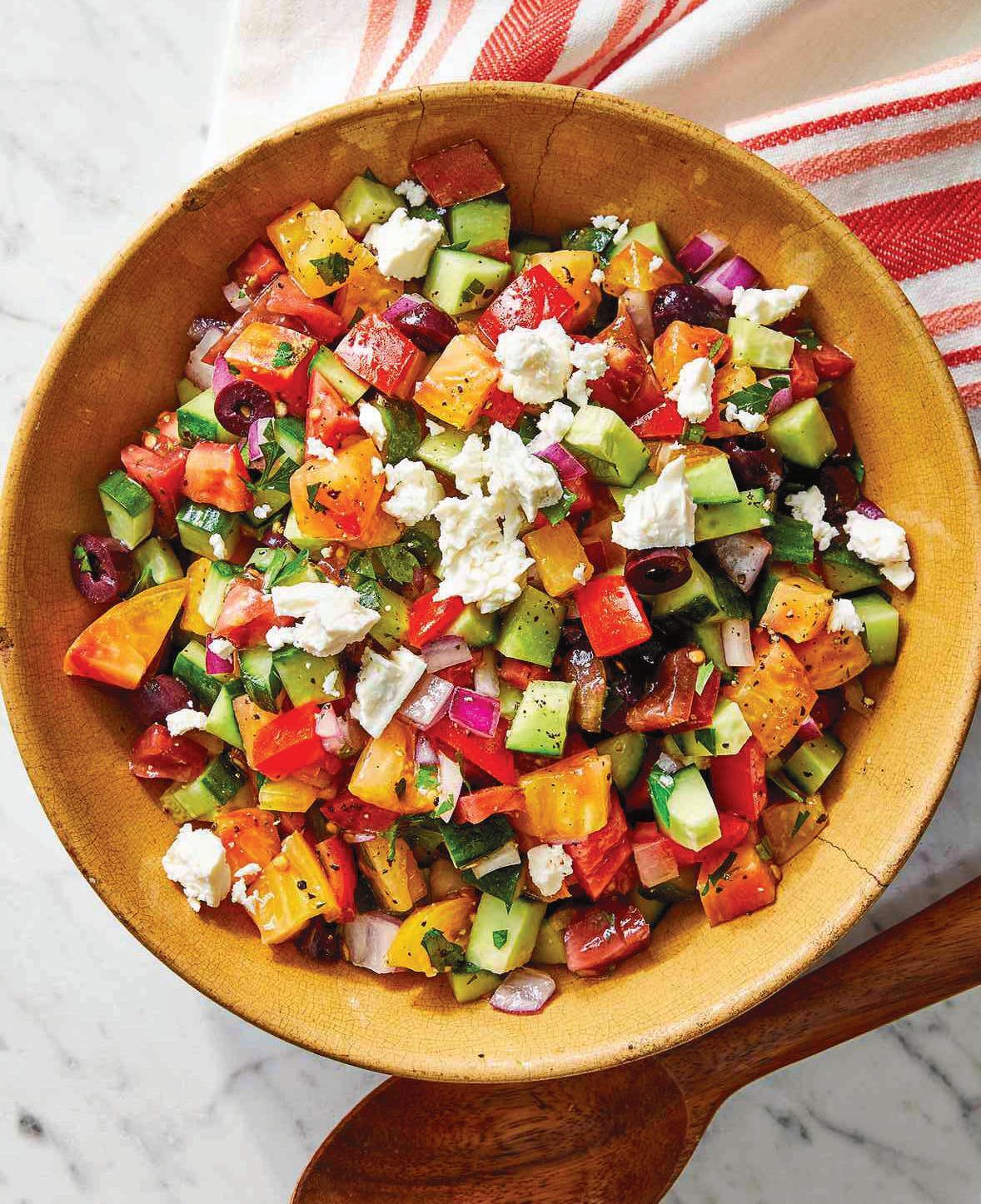
Yields 4-6 servings
INGREDIENTS
n 2 Tbs. extra-virgin olive oil
n 2 Tbs. red-wine vinegar
n 1 tsp. Dijon mustard
n ½ tsp. salt
n ½ tsp. ground pepper
n 1 medium English cucumber, diced
n 1 lb. ripe tomatoes, diced
n ¹/³ cup red onion, diced
n ¹/³ cup Kalamata olives, sliced
n ¼ cup fresh parsley, chopped
n feta cheese, for serving (optional)
DIRECTIONS
Whisk oil, vinegar, mustard, salt and pepper in a large bowl. Add cucumber, tomatoes, onion, olives and parsley and toss to coat. Serve sprinkled with feta, if desired.

“Year after year, the ‘Mediterranean Diet’ ranks as the number one best diet overall. This refreshing and simple twist on a classic Greek salad is a perfect example of what goes into that diet. Round out the meal with a fiber-rich carbohydrate such as quinoa, lentils or wild rice alongside some grilled fish, shellfish or chicken. Your heart will thank you!”
—Anna
Khesin, registered dietitian/nutritionist, Riverfront Nutrition, Oradell








Bergen Catholic is an independent, four-year college preparatory school where young boys, guided by the Essential Elements of an Edmund Rice Christian Brother Education, become Christian gentlemen and leaders who discover a devotion for helping others. The curriculum is rigorous. Students enjoy rewarding clubs, enriching programs in art, music, theater, championship athletics, and an unmatched brotherhood, where Brothers-Help-Brothers. The Crusader College Experience begins freshman year, providing support and results as evidenced by the fact that the Class of 2024 achieved acceptances to many top tier schools, including Duke, Notre Dame, United States Military Academy, Virginia, Michigan, Boston College, Columbia, Villanova, Wisconsin and Southern California. Enrollment is selective. For more information, email the Admissions Department at admissions@bergencatholic.org.
93% OF THE CLASS OF 2024 RECEIVED SCHOLARSHIPS AND GRANTS
$34.6
Enrollment is selective. For more information, please email admissions@bergencatholic.org


Ability School of Englewood has been educating children in Pre-K through 8th Grade for 40 years! Our 100% proficiencybased curriculum focuses on students as individuals and empowers them with the study tools they need for success. With small classes and a true sense of community, students enjoy hands-on, self-paced learning that allows them to achieve full mastery of their basics so they can apply what they’ve learned to real life. The school has a rolling enrollment.

At Academy of Saint Paul, we engage the whole child with traditional values in a modern world through a focus on scholarship, spirituality, and service. As a Blue Ribbon school, we strive for academic excellence with a rigorous curriculum utilizing technology, promote an active faith life to enhance your child’s spirituality, provide service and leadership opportunities, and offer a variety of extracurricular activities. Schedule a tour with us to see for yourself!
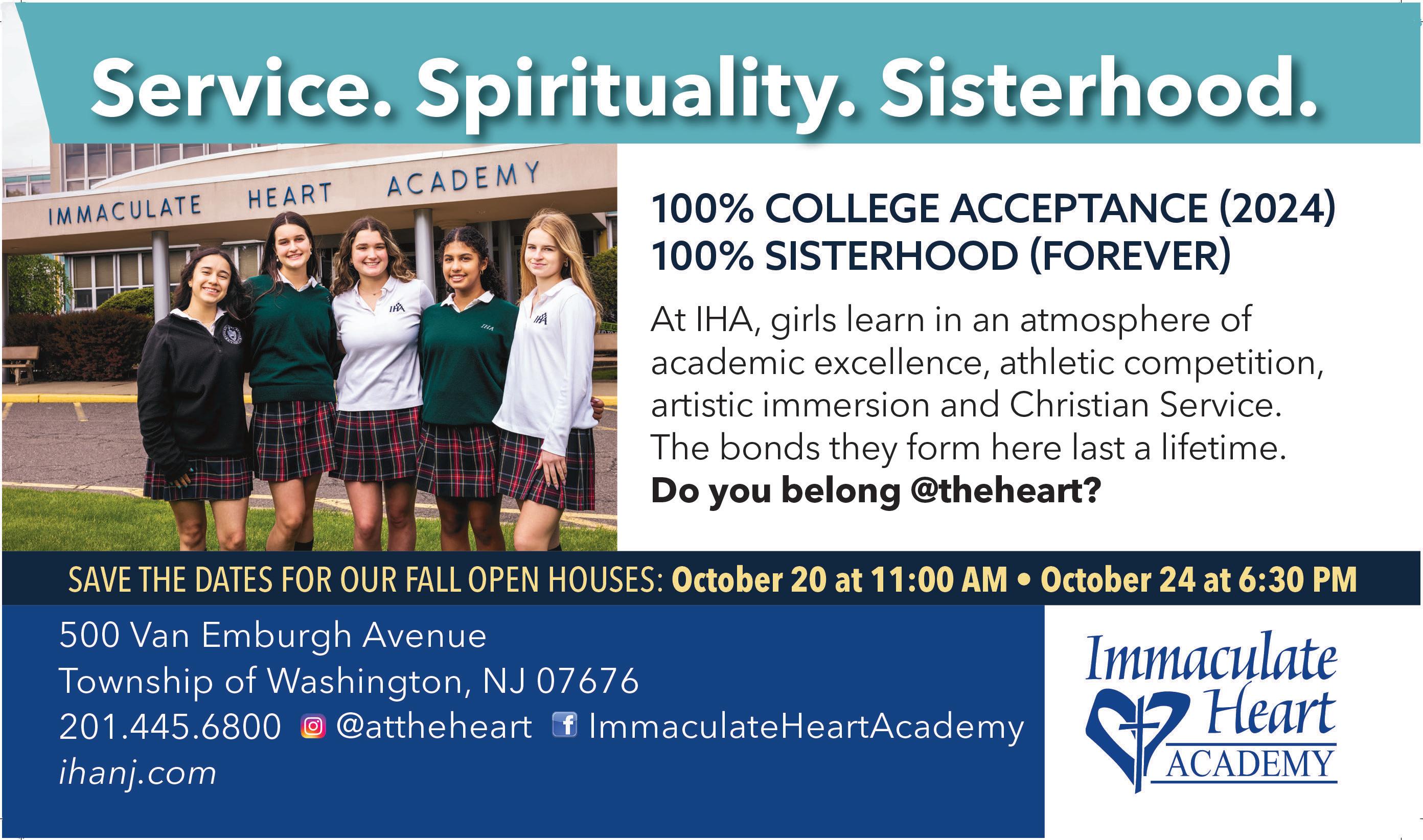

Founded in 2011, The Alliance represents 40 state-approved private special education schools in Northern and Central New Jersey. Our goal is to see that parents, school staff and advocates are well informed about the special education needs of, and range of program options for students with complex needs. We offer a searchable directory of schools on our website, free parent advocacy from a trained and knowledgeable parent advocate, workshops, resources and two annual scholarships.

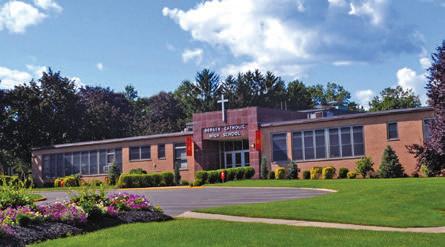




Bergen Catholic is an independent four-year college preparatory school founded by Edmund Rice Christian Brothers, where boys become Christian gentlemen. BC provides rigorous academics, rewarding clubs, and championship athletics. In addition, The Brotherhood provides an unmatched network of support. BC is proud of our four-year, results-driven college counseling program. 93% of the Class of 2024 received a college scholarship, and the total scholarship amounted to $34.6 mm. Enrollment is selective.
1040 Oradell Ave., Oradell, NJ | 201.261.1844 | www.bergencatholic.org
Chapel Hill Academy
At Chapel Hill Academy, we believe that students can achieve their fullest potential when they are learning in a supportive, nurturing atmosphere. Located in Lincoln Park, Chapel Hill Academy serves students grades K-12+ with social, emotional, and behavioral issues in a small school setting. We offer a rich and challenging curriculum, strong counseling support and creative, individualized learning to prepare students for the future. Most students are placed by the sending school district and attend at no cost to families.
31 Chapel Hill Rd., Lincoln Park, NJ | 973.686.0004 | www.chapelhillacademy.net
Don Bosco Prep www.donboscoprep.org
Discover your dream at Don Bosco Prep, where the spirit of St. John Bosco inspires academic excellence and personal growth. Our top-tier Catholic high school offers a comprehensive college-preparatory liberal arts curriculum in an environment rooted in faith and brotherhood. At Don Bosco Prep, you’ll find a supportive community that encourages you to excel, develop your character, and build lasting friendships, setting the stage for future success in college and beyond.
As a community of learners, Dwight-Englewood School strives to foster in each student a passion for life-long learning. We seek excellence, honor integrity, and embrace diversity in order to develop the skills, values, and courage to meet the challenges of a changing world and make it better. Our Open House Events and Campus Tours will be open for registration soon! Learn more at d-e.org/admissions.
Honor Ridge Academy
Honor Ridge Academy offers students and their families hope for a new future. For more than 40 years, we have been committed to life-changing special education for students in grades K-12 with social, emotional, learning, and behavioral disabilities. Teaching “the whole child,” we offer highly individualized instruction and a rich array of intensive therapeutic and behavioral supports, all provided by experienced educators in a family-like environment. We use positive behavioral supports consistently across all aspects of the program.
342 Madison Hill Rd., Clark, NJ | 732.827.5885 | www.honorridge.org


$53.2
CLASS OF 2024 AWARDED MILLION IN COLLEGE SCHOLARSHIPS




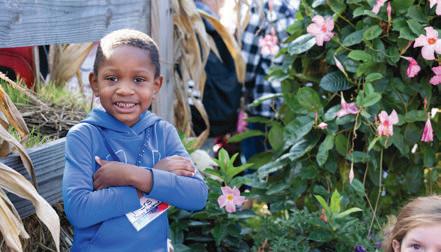

private experience. atmosphere encourages competition, and Christian Service. Our high-quality programs, superior facilities, and accomplishments of our high-achieving young women are second to none. 500 Van Emburgh Ave., Township of Washington, NJ | 201.445.6800 | www.ihanj.com
Kaplen JCC on the Palisades
The Kaplen JCC on the Palisades offers diverse facilities, such as fitness centers, aquatics centers, gymnasiums, tennis courts, an indoor track, a spa, and multiple playgrounds. We provide inclusive programs for all ages and foster community through wellness, education, arts, and recreation, all while being deeply rooted in Jewish values.
411 E Clinton Ave, Tenafly, NJ | 201.569.7900 | www.jccotp.org
Mary Help of Christians Academy 659 Belmont Ave., North Haledon, NJ | 973.850.7445 | www.maryhelp.org
Mary Help of Christians Academy is a private, all-girls, Catholic preparatory school where students realize their potential and watch their passions come alive in a community committed to faith, Salesian tradition and excellence. Situated on over 16 acres, we offer dual enrollment with FDU and Seton Hall and comprehensive Athletics and Arts programs. Come see MHC Academy for yourself at our Fall Open House, Wednesday, October 30th or Sunday, November 3rd. To register: www.maryhelp.org/ohreg/
We base our instruction on individual student needs, and work closely with the families to increase their child’s success. We provide programs for infants, toddlers, preschool, and Kindergarten. A curriculum designed for each age group will enrich your child physically, intellectually, emotionally, and socially. Our professional, experienced, certified teachers implement our program, along with qualified teacher’s assistants, providing stability and consistently superb quality of teaching and interaction with your child.
875 Route 17, Ramsey, NJ | 201.934.8009 | 157 Franklin Tpke., Waldwick, NJ | 201.445.2643
Saddle River Day School 147 Chestnut Ridge Rd., Saddle River, NJ | 201.327.4050, ext. 1108 | www.saddleriverday.org
Saddle River Day School is a coed, college prep day school enrolling approximately 530+ students in grades PreK3-12. Students experience integrated and applied learning in a hands-on rigorous academic setting with a low student-teacher ratio. The NJAIS accredited school boasts pristine facilities such as a fully equipped Center for Innovation & Entrepreneurship and state-of-the-art graphic design center. Graduates are prepared for entry to some of the nation’s most selective colleges such as Columbia, Emory, NYU, Stanford and UVA.









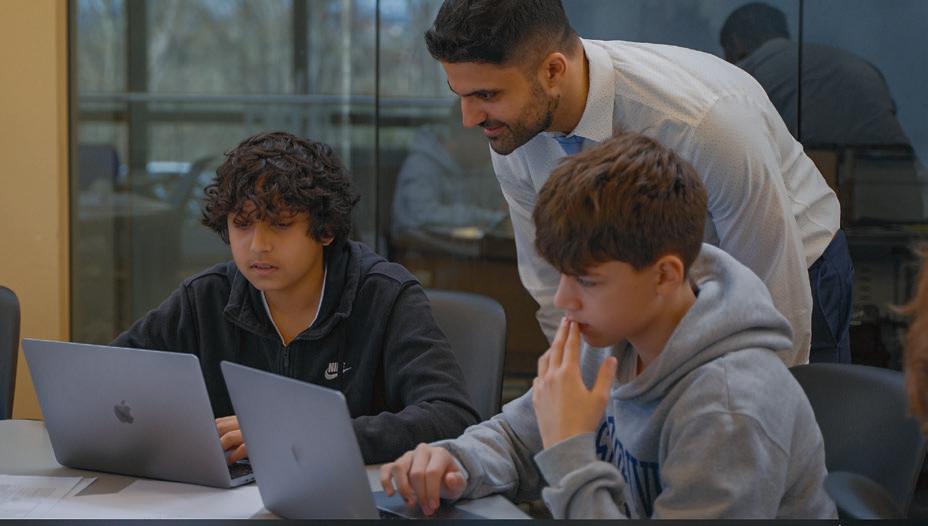
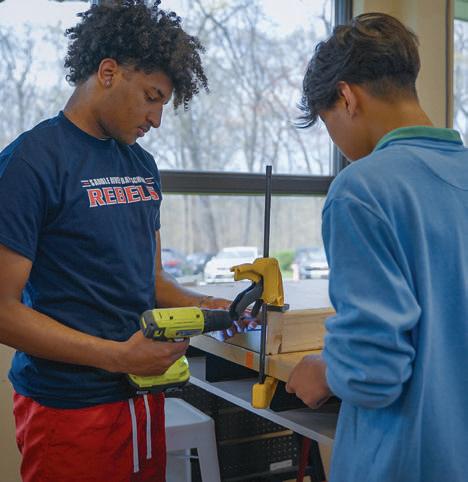

A leader in early education since 1930, The Elisabeth Morrow School personalizes learning for each child, cultivating their unique spark and innate creativity. Through an engaging project-based curriculum, students connect learning across subjects. Contact us to find out how — through initiatives in science,
the arts, and mathematics
design studios and eighth-grade capstone projects — we prepare children to lead the way with innovative thinking, ready to make a difference in their world.




www.maryhelp.org/ohreg/
FRI, NOV. 17
www.maryhelp.org/pdreg/ (must pre-register for events)



•
•
•
•
•










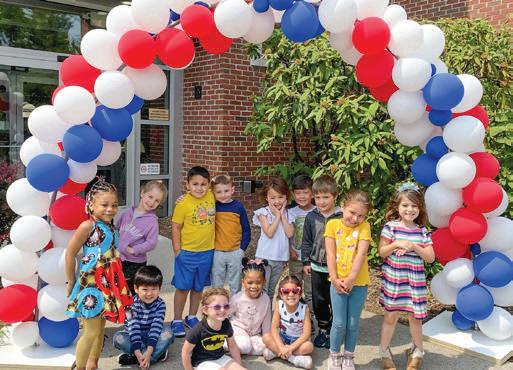
Introduce your child to a community they can grow with into adulthood. We weave our core values—honesty, respect, caring, and responsibility—into all our programming and understand that the essential life skills learned today create a strong foundation for tomorrow’s successes! We offer flexible schedules with a curriculum built around STEM, language skills, Spanish, music, art, and more. Our facility provides a one-of-akind learning environment with time in our exercise studios, gymnasium, playground, and pool. Y family membership included with enrollment. Financial Aid available.

For over 50 years, Young World Day School’s experienced staff has provided a safe, nurturing environment for children to grow academically, socially, and emotionally. We offer a choice of traditional or Montessori preschool, a transitional kindergarten, and a traditional kindergarten. Our grades 1 and 2 feature a mixed-age classroom where academics match students’ abilities and learning styles. Weekly enrichment includes Spanish, soccer/yoga, music, computers, and outdoor recreation. Join the YWDS family!













Individually designed
College prep & remedial
Career/Transition Coordinator
Counseling
LTDC/Reading Specialist

Gifted & talented opportunities
IT & tech certifications
Social skills training daily
Individualized & school-wide behavior supports









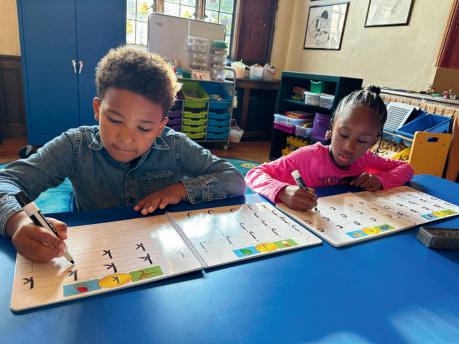









Unless I was on a tiring road trip or hunkering down in a remote location, I typically avoided restaurants attached to hotels in the early aughts. I frequently associated them with an expectation that the service would be sub-par and the food potentially worse, whether they were big-chain eateries or momand-pop burger joints. I know today that the old thinking was unfair—and wrong.
The undoing of my former beliefs started when Biggie’s occupied the space connected to the Ramsey Best Western, because it was gosh darn good. Nearly five years have passed since Biggie’s closed that location (another bar and grill with equally tasty eats had moved in but recently shut down), so I was eager to see the changes when I returned to the spot last month.
The biggest change is food: A new team has opened Mehfil Café, specializing in traditional and modern Indian cuisine. The menu features flavors from both the northern and southern regions of India, fusion-inspired items such as bao buns and chicken tikka burgers as well as chicken tenders and French fries. There are reminders of the previous tenants still in place, namely the large bar and lounge area, where bands and DJs often perform during dinnertime and well into the night.
While the band played a set list of classic rock jams, my dining companion and I flipped through the extensive menu and volleyed with our food ideas. Fusion didn’t strike our fancy (we’ll try naan pizza and paneer-filled tacos another time), so we picked two familiar flavors to start. Our first was pani puri, a common street food found throughout markets and bazaars in India. The dish comes with crispy, hollow puris (fried dough balls) that diners fill with finely diced potato, red onion, peas and chickpeas. Once they’re filled, either tangy tamarind chutney or mint water is poured onto the mixture and then shoveled into the mouth. Though assembling each piece is a fun experience, it’s even better to enjoy the wonderful crunch of the puri and the blend of flavors.
Speaking of flavor, our second appetizer had plenty. As a nod to the former Biggie’s tasty wings, I ordered Mehfil’s wing app with its 65 sauce. This south India specialty combines



large, deep-fried wings with a sauce made from yogurt, lemon juice, spices and chili. These wings don’t claim to be old-fashioned buffalo wings or gastropub-esque garlic parm wings (those are on the menu, though), but 65 chicken is a fiery-hot dish that’s bursting with flavor and is a must-try here.
With our taste buds warmed up, we were ready to dive into the main dishes as soon as they arrived at our table. I had toyed with trying the lamb shank biryani or the braised lamb curry, but I knew I’d made the right choice when I saw and smelled my entrée, Nizami mutton. The bowl contained numerous pieces of tender mutton cooked and served in an aromatic gravy. Though I’m a meat lover, I couldn’t get enough of the sauce, a delicious blend of tomato puree, cumin, saffron, chilis, cream and Nizami spices. The menu indicates that it’s a spicy dish, but neither my friend nor I required a cool beverage to soothe our tongues. (Pro tip: Even if you don’t need a drink like mango lassi to extinguish proverbial flames, try Mehfil’s mango lassi anyway. You’ll thank me later.)
My friend, meanwhile, had the mixed vegetable korma with a cardamom-infused sauce. This dish came loaded with an assortment of fresh vegetables, simmered and served in a divine cream sauce. While popular Indian buffet options such as butter chicken and tikka masala have finger-licking good sauces, both bow in comparison. The richness and unique taste of the korma dish are to be savored, relished—and sopped up with every grain of rice on the plate and piece of naan at the table.
Filled to the brim with meat, veggies, rice and bread, we could only manage a small order of gulab jamun for dessert (condensed milk “balls” in sweet syrup), and it was worth squeezing it into our bellies. After we wrapped up dinner, we walked a few steps to the lounge area, where the band finished a rendition of U2’s “Where the Streets Have No Name.”
“Doesn’t it smell great in here?!” the lead singer asked the audience of diners.
It tastes great too.
—Darius Amos
Outdoor music, all-star comedians and ways to enjoy the great outdoors—you’ll never run out of summer fun in Bergen County.


AUG. 12
Take to the water at the Paddling Center at Overpeck Park in Leonia, where Hackensack Riverkeeper is offering BEGINNER-LEVEL
KAYAK LESSONS at 10 a.m. Students will learn the basics of water safety, personal floatation device fitting, safe entrances and exits from the water and paddling techniques. Participants will then hour of time on the water. Lessons are free kayak rental; visit hackensackriverkeeper.org for additional information.

AUG. 17
AUG. 13
Enjoy a free concert under the stars during MUSIC AT RIVERSIDE at Riverside County Park North Arlington. Bring your own blankets and chairs and sit back as New Jersey-based cover band Suit and Mai Tai perform songs by The Eagles, Billy Joel, Fleetwood Mac and more. The show kicks off at 7 p.m. For more information, visit co.bergen.nj.us.
AUG. 14
“But, soft! What light through yonder window breaks?” ’Tis the summer tradition of SHAKESPEARE IN THE PARK, presented by the Hackensack Performing Arts Center. Join them for a presentation of the Bard’s best-known work, Romeo and Juliet, and enjoy the classic tale of young love turned tragic. The show starts at 7:30 p.m. Head over to hacpac.org for more information.
AUG. 16

Do you want a real physical challenge? Try out the INTERSTATE 17 TRAIL RUN in Closter, which was created to be just that. This 17-mile trail race includes about 5,000 feet of elevation change throughout. You also couldn’t ask for a better location—while you push yourself to the limit, you’ll Hudson River. For more registration, see runsignup.com.
AUG. 22
If you love motorcycles, in luck. Bergen County Davidson in Rochelle hosting BIKE NIGHT

Want to make family movie night extra memorable? Spend it at Van Saun Park in Paramus during MOVIES AFTER DARK, an outdoor movie screening hosted by the Bergen County Department of Parks & Recreation. The evening’s feature is the Disney animated movie Elemental, which is rated PG. The film begins at 8:30 p.m. and is free for all (just bring your own blankets and chairs). For more information, see co.bergen.nj.us.

5 p.m. Join other enthusiasts music, food trucks, prizes—and, of course, motorcycles. For bergenharleydavidson.com.
AUG. 24
Get ready to when the Bananas Club in Rutherford JAY JURDEN An writer and an old hand circuit (he’s worked with Tonight , The Late Late Show and The Drew Barrymore Show, just to name three), Jurden was named one of Variety’s 10 Comics To Watch in 2022. For tickets and showtimes, see bananascomedyclub.com.


golfbergencounty.com.

Rutherford best brightest of the comedy world when the Williams Center for the Arts hosts ALL-STAR COMEDY LINEUP: THE NEXT BIG THING Enjoy an evening with four comedians from all corners of the country. Doors are at 8 p.m., the show starts p.m. For tickets and full lineup information, to williamscenter.co.

Bergenites always show up to support their friends and neighbors.

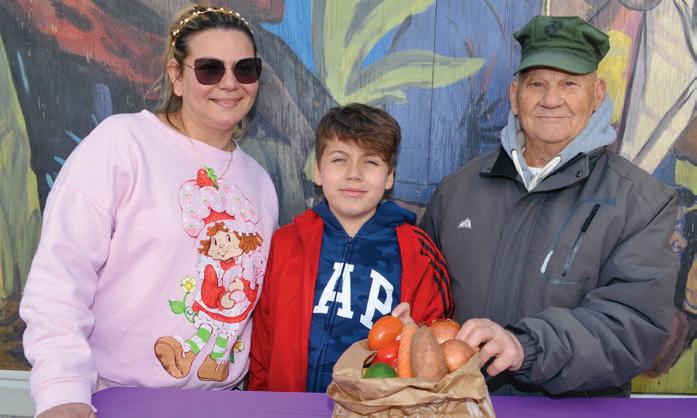

1. THE ELISABETH MORROW SCHOOL
Tenafly resident and area high school student
Trevor Ostfeld met with children at The Elisabeth Morrow School in Englewood. He talked about his humanitarian experience in Ukraine, which inspired him to write his first book Finding Messi: The Miracle Cat From Kyiv



2-3. THE COMMUNITY CHEST
The Community Chest of Eastern Bergen County held its fourth annual Golf Outing at Edgewood Country Club in River Vale. The event, which included golf, a cocktail hour and dinner, raised funds for The Chest’s initiatives and to support grant awards for local nonprofit agencies.
4-5. TABLE TO TABLE
Table to Table, New Jersey’s first food rescue organization, received a $100,000 grant from Impact100 Garden State for its program, Food Rescue Heroes: Bridging the Gap Between Food Waste & Food Insecurity. The funding will allow the nonprofit to expand its mission of rescuing food, reducing waste and relieving hunger.
Ramapo-Bergen Animal Refuge Inc. (RBARI) recently benefited from the volunteer work of Girl Scout Troop 96807 from Franklin Lakes. These Scouts have been working hard with their donation drive for the shelter animals, including dog, cats, rabbits and guinea pigs.
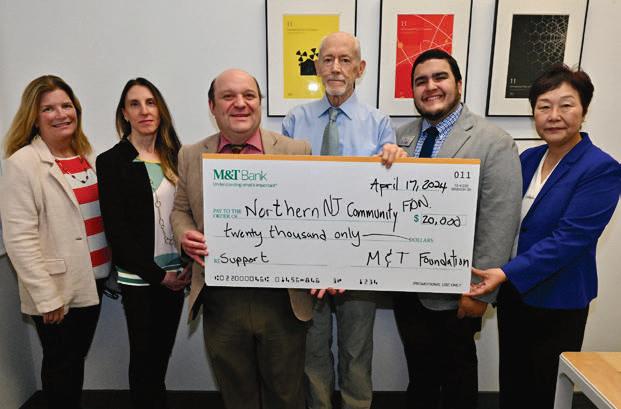

The Northern New Jersey Community Foundation received a grant award from The M&T Charitable Foundation. Pictured at the presentation: Alle Ries, Danielle DeLaurentis, Leonardo Vazquez, Michael Shannon, Brendon Feliciano, Kathleen Carrasco
8. HABITAT FOR HUMANITY
Veolia’s New Jersey Division was honored for its partnership with Habitat for Humanity of Bergen County and its work to build affordable housing for families in Northern New Jersey. Pictured at the celebration: Sonja Clark, Adela Wekselblatt, Andrea Potto, Karen Roberts, Donna Koeniges, Kathleen Kennedy, Taylor Carden

“After moving to Franklin Lakes two years ago, I am amazed at how many wonderful, natural and beautiful places there are to hike and walk with my dog Molly. Here we are behind Indian Trail Club after a long day at work, going for a quick, spontaneous walk and stopping suddenly to admire the glorious view.”
—Jim Shammas, Franklin Lakes
Send us your Bergen Moment! Email your photo and a short description to rita.guarna@wainscotmedia.com.



